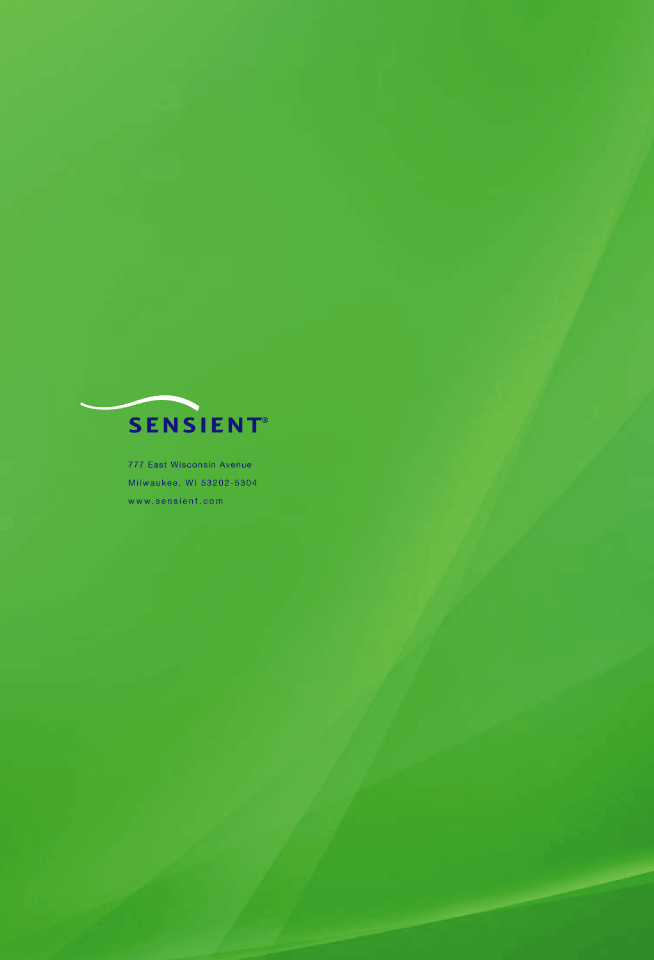Attached files
| file | filename |
|---|---|
| 10-K/A - FORM 10-K/A - SENSIENT TECHNOLOGIES CORP | c61215ae10vkza.htm |
| EX-21 - EX-21 - SENSIENT TECHNOLOGIES CORP | c61215aexv21.htm |
| EX-32 - EX-32 - SENSIENT TECHNOLOGIES CORP | c61215aexv32.htm |
| EX-31 - EX-31 - SENSIENT TECHNOLOGIES CORP | c61215aexv31.htm |
Exhibit 13.1
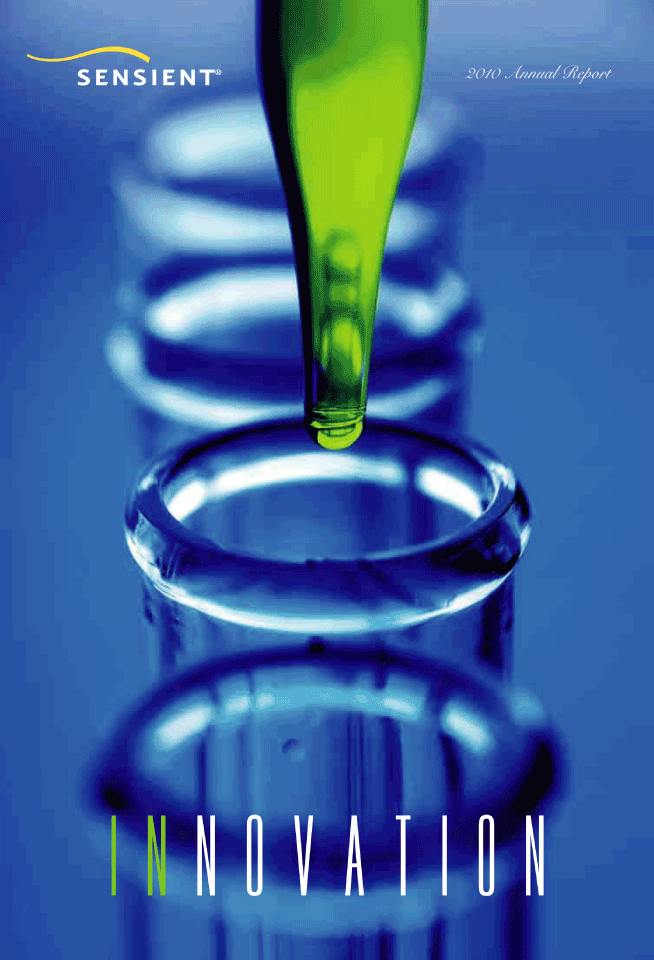
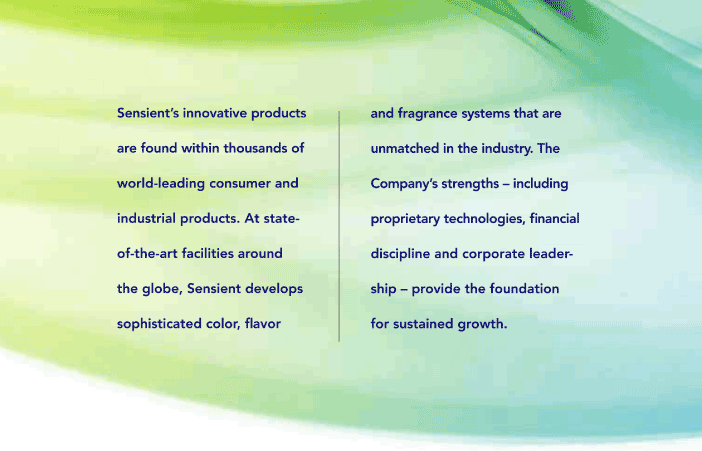
“ Sensient had a record-breaking year. All our Groups achieved significant growth. Strategic
initiatives position the Company for future success in markets around the world.”
Kenneth P. Manning
Chairman and Chief Executive Officer
Chairman and Chief Executive Officer

FINANCIAL HIGHLIGHTS
in thousands except per share, employee and shareholder data
in thousands except per share, employee and shareholder data
| Years ended December 31, | 2010 | 2009 | % Change | |||||||||
Results of operations |
||||||||||||
Revenue |
$ | 1,328,180 | $ | 1,201,412 | 11 | % | ||||||
Operating Income |
174,577 | 146,963 | 19 | % | ||||||||
Net Earnings |
107,144 | 86,561 | 24 | % | ||||||||
Per common share |
||||||||||||
Net Earnings: |
||||||||||||
Basic |
$ | 2.18 | $ | 1.79 | 22 | % | ||||||
Diluted |
2.17 | 1.78 | 22 | % | ||||||||
Dividends |
0.79 | 0.76 | 4 | % | ||||||||
Book Value |
19.70 | 18.49 | 7 | % | ||||||||
Other information |
||||||||||||
Capital Expenditures |
$ | 55,823 | $ | 47,716 | ||||||||
Depreciation and Amortization |
$ | 43,423 | $ | 42,183 | ||||||||
Total Debt |
$ | 349,810 | $ | 428,033 | ||||||||
Number of Employees |
3,618 | 3,570 | ||||||||||
Number of Shareholders of Record |
2,977 | 3,082 | ||||||||||
Average Common Shares
Outstanding: |
||||||||||||
Basic |
49,138 | 48,379 | ||||||||||
Diluted |
49,424 | 48,641 | ||||||||||
1
LETTER TO SHAREHOLDERS
March 15, 2011
2010 was a record year for Sensient Technologies Corporation. We earned all-time record revenue of
$1.33 billion, an increase of 10.6% over 2009. The Company’s net earnings reached $107.1 million,
which is also an all-time high.
A Record Year
Sensient’s
record financial performance in 2010 reflects our Company’s fundamental strengths: we have
leading-edge products, worldwide reach, disciplined leadership and a strong balance sheet. All our
Groups contributed to the Company’s growth, with the Color Group delivering double digit percentage
revenue increases.
Sensient continued to execute our long-term strategic plan in 2010 without interruption. Our
well-executed strategic initiatives position Sensient for sustained and robust growth as the global
economy recovers.
Wall Street and the larger investment community took notice of Sensient’s strong performance. As of
December 31, 2010, the Company’s market capitalization was $1.8 billion, which represents a 42%
increase in value compared to December 31, 2009.
On January 21, 2011, the Board of Directors announced an increase in the quarterly cash dividend on
the Company’s common stock to 21 cents per share. We believe that shareholders should benefit
directly from our continued strong performance. Sensient’s dividend has risen more than 40% over
the past five years.
Operating from a Position of Financial Strength
In 2010, Sensient reduced debt
by more than $78 million, bringing
total debt to $350 million. For
the first time since 1999, the
Company’s total debt has been
reduced below $400 million.
Sensient’s total debt to total
capital is now below 27%.
Sensient’s financial strength allowed us to make key investments in advanced technology and
facilities improvements in 2010. These investments are critical to future growth, and we will
continue to make strategic capital investments moving forward.
Leading Products for Global Markets
Sensient is a leading global developer, manufacturer and distributor of advanced color, flavor and
fragrance systems for manufacturers worldwide. Our products contribute to the success of thousands
of consumer goods representing some of
the world’s best-known brands. Sensient’s value-added systems are found in food, beverages,
cosmetics, pharmaceuticals, inkjet inks and many other consumer and industrial products.
In recent years, Sensient has capitalized on the growing global market for natural colors and
flavors. Developing high-performance natural products for large-scale industrial use is a
challenging task requiring advanced scientific techniques. Today, no competitor’s offerings exceed
the quality of Sensient’s natural color and flavor systems.
Sensient’s proprietary CO2 extraction capabilities produce natural flavor systems used by
a wide range of customers. Our emulsion and micro-emulsion technologies provide the foundation of
advanced natural color systems used by manufacturers of foods, beverages and cosmetics.
The Company also continues to achieve substantial growth in several non-food sectors with global
markets. Our inkjet ink business benefited in 2010 from strong demand for our printing inks.
Sensient’s inkjet technology
2
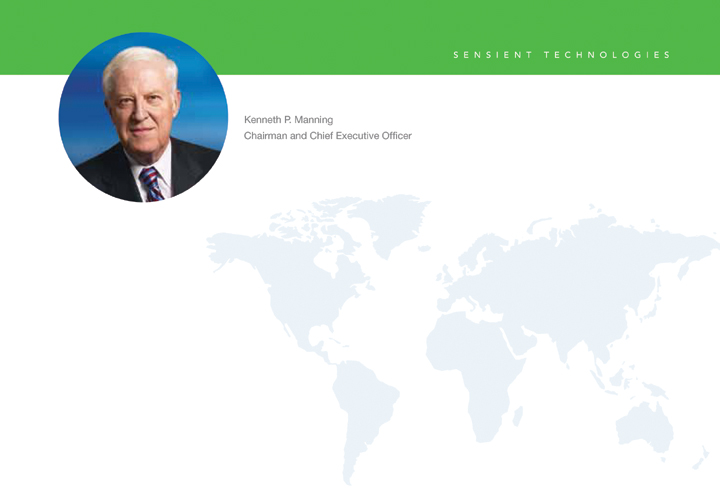
is also used by manufacturers of textiles and sports equipment.
Sensient continues to see growth and opportunity in the worldwide market for pharmaceutical colors
and coatings. Sales of natural and synthetic systems for cosmetics are also increasing at a
significant rate. We expect revenues from pharmaceutical and cosmetics systems to grow in both
established markets and developing nations.
The
Company’s product mix reflects the breadth and depth of Sensient’s technological capabilities.
We maintain technical services, labs and pilot plants at locations around the world. Our R&D
capabilities enable us to customize and extend key products, as well as to develop entirely new
offerings.
Strategic Investments in Facilities
Sensient has made strategic
capital investments at several
facilities so that customers
worldwide have greater access
to our leading technologies and
product development services.
In St. Louis, our investments will significantly increase
manufacturing capacity for pharmaceutical coatings and natural food colors. We also enhanced
product development and manufacturing capabilities for savory flavors and extractions at our
Indianapolis facility.
Sensient recently opened an extensive, state-of-the-art facility in Guangzhou, China. This location
brings key Sensient technical operations, including aseptic processing and emulsion production, to
one of the most dynamic markets in the world. We conduct business from five locations in China:
Guangzhou, Hong Kong, Shanghai, Beijing and Qingdao.
Extending Sales to New Locations
For more than a decade, Sensient has been expanding our global presence. We are a highly regarded
development partner and supplier among manufacturers in leading European, Latin American and Asian
markets. In 2010, more than 60% of our revenues came from sales outside the United States.
Sensient is now reaching key secondary markets through our
extended distribution system. We have added several new locations in Central Europe and
Scandinavia.
Looking Forward
| Sensient’s solid financial position, disciplined operations and leading technology-based products all contributed to our success in 2010. We have continued to stay the course in a challenging economic environment. |
The Company’s strategic initiatives, sound investments and geographic expansion position us to
succeed. I am very optimistic about Sensient’s future opportunities.
Sincerely,

Kenneth P. Manning
Chairman and Chief Executive Officer
Chairman and Chief Executive Officer
3
BUSINESS PROFILE

Sensient
develops, manufactures and distributes flavor and fragrance systems that are found in
thousands of consumer products worldwide. The Company’s specialty systems are essential components
of food, beverage, household and personal care products.
Sensient’s value-added flavors and
fragrances enable our customers to excel in highly competitive global markets.
STRATEGIC ADVANTAGES
| • | Complete product line of proprietary flavors and ingredient systems | ||
| • | Industry-leading extraction and reaction flavor technologies | ||
| • | Technical capabilities for product development, extension and customization | ||
| • | Extensive international sales and technical resources |
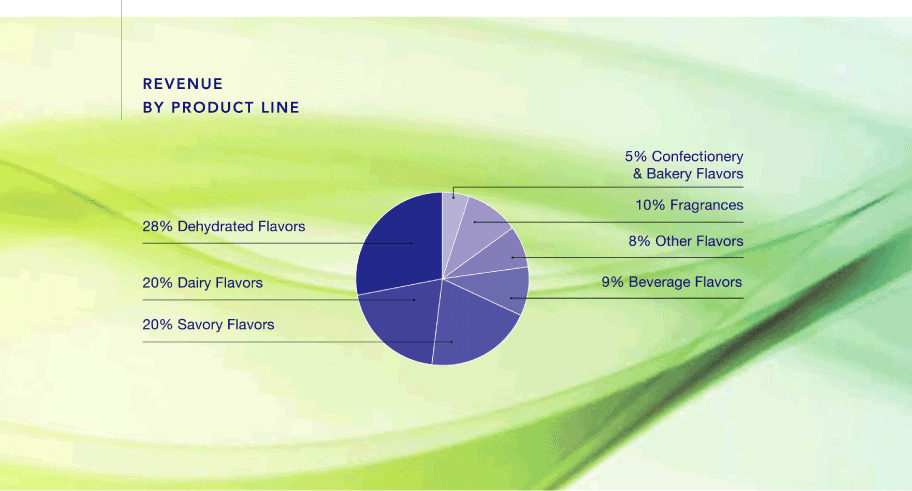
4
SENSIENT TECHNOLOGIES

Sensient is a leading developer, producer and supplier of natural and synthetic color systems for
customers around the globe. The Company’s high-performance products play a central role in the
manufacture of foods and beverages, cosmetics and pharmaceutical colors and coatings, inks for
commercial and consumer printers, and colors for agricultural uses, household cleaners and paper
products.
STRATEGIC ADVANTAGES
| • | A broad product mix serving global markets and multiple regulatory environments | ||
| • | Advanced natural color technologies in North America and Europe | ||
| • | Expanding technical and manufacturing capabilities in natural colors, pharmaceutical colors and coatings and commercial and desktop inks | ||
| • | Leading pigment dispersion, emulsion and coating technology expertise |
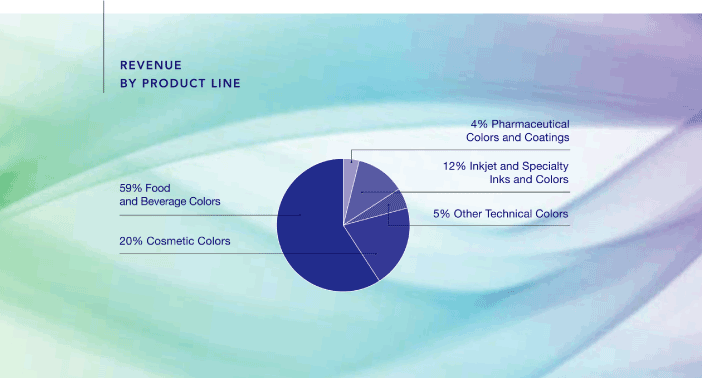
5
SENSIENT TECHNOLOGIES
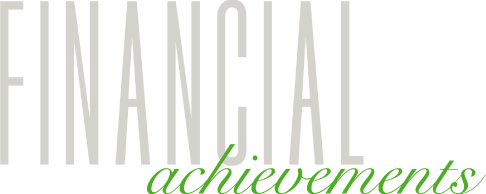
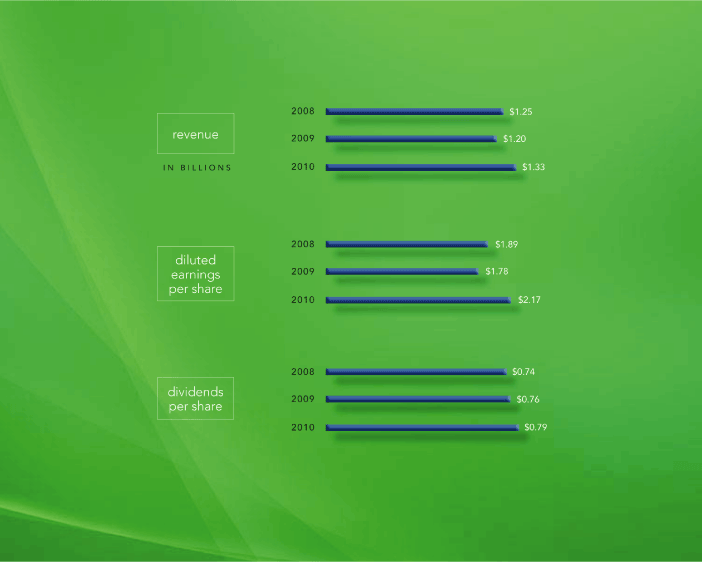
6
In 2010, Sensient achieved record revenue of $1.33 billion and record earnings of $107.1 million.
Sensient increased its quarterly cash dividend to $0.21 per share of common stock on January 21,
2011, allowing shareholders to immediately benefit from the Company’s success. The dividend has
increased by more than 40% over the last five years. The Company had record cash flow of $155.7
million in 2010 and reduced debt by $78 million, bringing total debt-to-capital down to 26.2%. We
see no obstacles to our future financial performance.
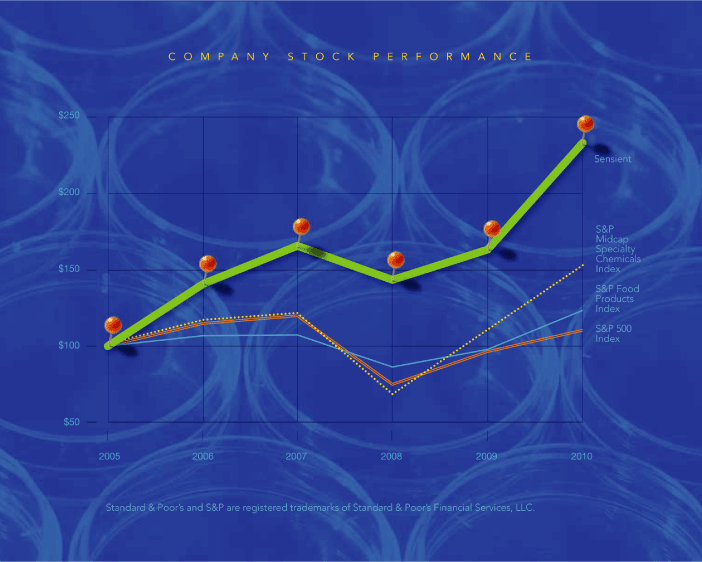
SENSIENT TECHNOLOGIES
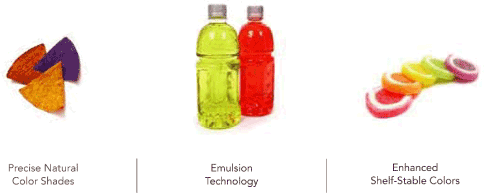


Sensient continues to expand sales of our industry-leading natural food and beverage color
systems. Sensient is one of the largest and most advanced natural color providers in the
world. The Company uses several advanced technologies to produce high-performance natural
colors for the global marketplace. In 2010, Sensient expanded R&D and manufacturing
capabilities at our main North American color facility in St. Louis, which is the largest
color plant in the world. We completed significant improvements to facilities in Germany,
Italy and China. The Company also develops and manufactures color systems at facilities in
Australia, Brazil, the United Kingdom and other nations.
9
SENSIENT TECHNOLOGIES
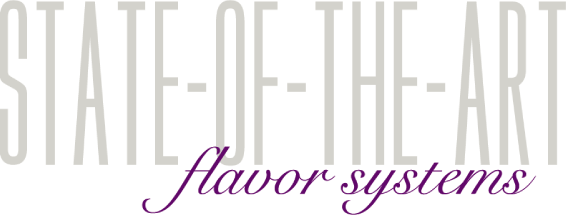
Sensient’s advanced flavor technologies enable us to extend a broad base of flavor
systems as well as create entirely new products. The Company’s flavor systems enhance
the products of food and beverage manufacturers worldwide. We recently implemented
extraction technology that produces significantly more robust flavors than traditional
extracts. Sensient’s combination of product depth, industry-leading facilities and
global reach helps win new business and makes us a supplier of choice among leading
multinationals.
10
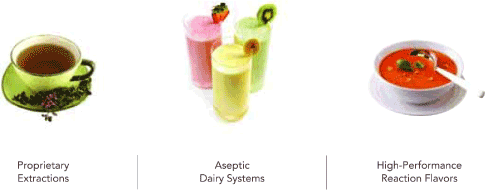

SENSIENT TECHNOLOGIES
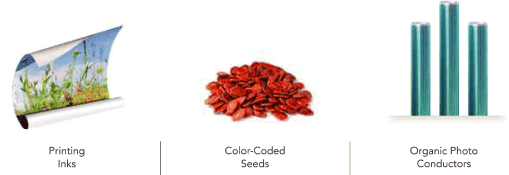


Sensient develops high-quality colors and fine chemicals for numerous manufacturing
sectors with worldwide markets. The Company’s high-performance inks are used by
makers of commercial and consumer inkjet printers, packaging, sports equipment and
textiles. We also produce highly purified chemicals called organic photo conductors
(OPCs) that are fundamental to the operation of laser printers and photocopiers.
Other Sensient color technologies are used in household and institutional cleaners,
agricultural applications and many other products.
13
SENSIENT TECHNOLOGIES

Sensient continues to find significant growth in the global market for colors used in
pharmaceutical and cosmetics manufacturing. The Company’s natural and synthetic color and
coating systems for pharmaceuticals are increasingly sought by customers in North America,
Asia and Europe. Sensient also develops and markets advanced systems for cosmetics to meet a
growing global demand for health and beauty products. In 2010, the Company’s cosmetics and
pharmaceutical businesses both achieved double digit percentage sales growth.
14
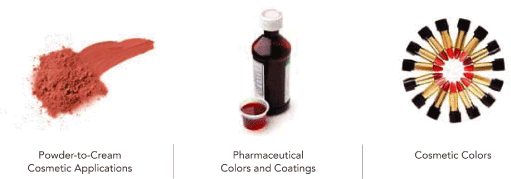

SENSIENT TECHNOLOGIES
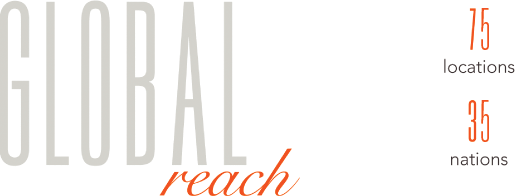
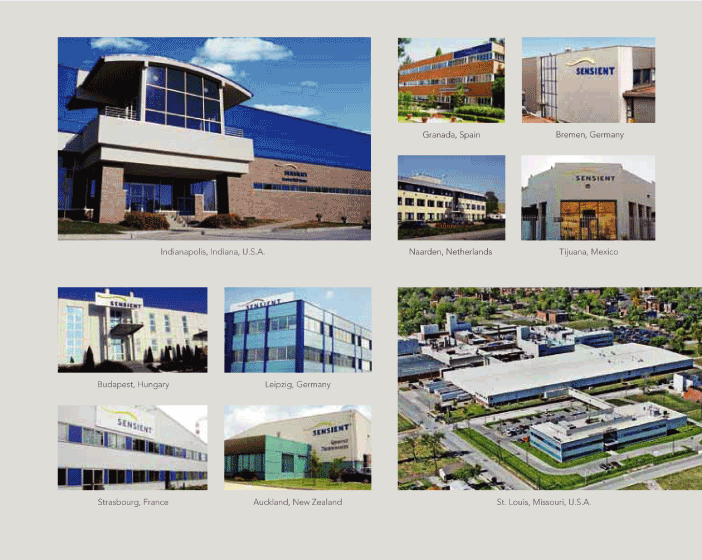
16
Sensient’s global reach enables us to meet diverse customer needs, access key markets and
differentiate our Company from competitors. Sensient now operates
from 75 locations in 35 nations.
Sensient recently opened a new flagship facility in Guangzhou, China. This location positions us for
growth in China with advanced research, application development and production capabilities. The
Company also expanded our St. Louis facility to increase manufacturing capacity for natural colors
and pharmaceutical coatings. Sensient recently established locations in several growing European
markets as well, including Poland, Romania and the Ukraine.
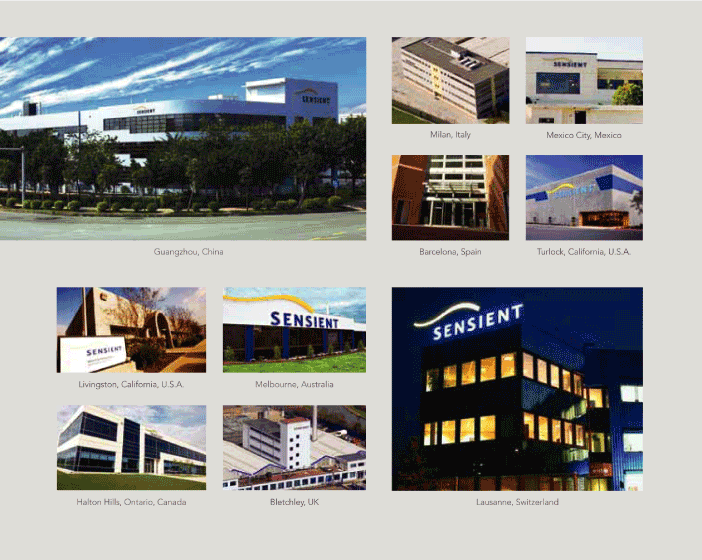
17
FINANCIAL REVIEW 2010
TABLE OF CONTENTS
19
|
Management’s Discussion & Analysis of Operations & Financial Condition | |
27
|
Consolidated Statements of Earnings | |
28
|
Consolidated Balance Sheets | |
29
|
Consolidated Statements of Cash Flows | |
30
|
Consolidated Statements of Shareholders’ Equity | |
32
|
Notes to Consolidated Financial Statements | |
46
|
Management’s Report on Internal Control Over Financial Reporting | |
47
|
Report of Independent Registered Public Accounting Firm | |
48
|
Report of Independent Registered Public Accounting Firm on Internal Control Over Financial Reporting | |
49
|
Quarterly Data | |
49
|
Common Stock Prices and Dividends | |
49
|
Company Stock Performance | |
50
|
Five Year Review | |
52
|
Directors & Officers | |
Inside back cover |
Investor Information |
18
| Management’s Discussion & Analysis of Operations & Financial Condition |
Sensient Technologies Corporation Annual Report 2010 |
OVERVIEW
For the year ended December 31, 2010, Sensient Technologies Corporation (the “Company”)
reported record revenue at the consolidated level and at each of its groups. Earnings per share
reached new all-time highs for each quarter and for the year in 2010. The Company also continued to
strengthen its financial position in 2010. Cash flows from operating activities were up 12.6% to a
record level, allowing the Company to reduce debt by over $78 million in 2010 and more than $130
million in the last two years. The Company continued to expand its geographical presence through
its extended distribution system by opening new locations in Central Europe in 2010.
In 2010, the Company finalized the insurance settlements for the environmental claims related to
the $11.3 million of charges (fourteen cents per share after tax) recorded in 2009. Additional
insurance proceeds received during the current year on this matter increased 2010 operating profit
by $1.5 million (two cents per share after tax). The following table summarizes the impact of the
settlement of environmental claims on Sensient’s operating income and diluted earnings per share:
| 2010 | 2009 | |||||||||||||||
| (in thousands | Diluted | Diluted | ||||||||||||||
| except per | Operating | Earnings | Operating | Earnings | ||||||||||||
| share amounts) | Income | per Share | Income | per Share | ||||||||||||
As reported |
$ | 174,577 | $ | 2.17 | $ | 146,963 | $ | 1.78 | ||||||||
Settlement charges (gain) |
(1,458 | ) | (0.02 | ) | 11,297 | 0.14 | ||||||||||
| $ | 173,119 | $ | 2.15 | $ | 158,260 | $ | 1.92 | |||||||||
Revenue
(In Billions)
(In Billions)

Consolidated revenue was $1.33 billion in 2010, an increase of 10.6% from $1.20 billion
reported in 2009. Sensient’s operating income was $174.6 million in 2010, up 18.8% from $147.0
million in 2009. Excluding the impact of the settlement of environmental claims, operating income
was up 9.4%. The impact of foreign currency translation increased revenue and operating income by
approximately 1%. Diluted earnings per share, as reported, were $2.17 in 2010 compared to $1.78 in
2009. Excluding the impact of the settlement of environmental claims, diluted earnings per share
were up 12.0%. Cash flows from operating activities were $155.7 million, an increase of 12.6% from
$138.3 million reported in 2009. Total debt was reduced by $78.2 million during 2010 as a result of
the strong cash flow. Sensient’s debt to capital ratio improved to 26.2% at December 31, 2010,
compared to 32.0% at the end of 2009.
Additional information on these items is included in the Results of Operations.
RESULTS OF OPERATIONS
2010 vs. 2009
Sensient’s revenue increased 10.6% in 2010 to $1.33 billion from $1.20 billion in 2009.
Revenue in the Flavors & Fragrances Group was $809.1 million in 2010, an increase of 4.7% from
$772.9 million in 2009. Color Group revenue of $447.5 million was 19.4% higher than 2009 revenue of
$374.8 million. Corporate and Other revenue, which includes the Company’s operations in the Asia
Pacific region and China, increased 28.0% in 2010. The impact of foreign currency translation
increased consolidated revenue in 2010 by less than 1%. Additional information on group results can
be found in the Segment Information section.
The Company’s gross margin was 30.7% in both 2010 and 2009. The impact of increased selling prices
and favorable product mix was offset by the impact of higher raw material and
manufacturing costs in 2010.
Selling and administrative expense as a percent of revenue was 17.6% in 2010 compared to 18.5% in
2009. In 2009, the Company recorded charges of approximately $11.3 million, or 0.9% of revenue, for
the settlement of environmental claims against the Company. The Company also recorded a gain in
2010 of $1.5 million due to additional insurance proceeds received on the environmental claims. The
increase of selling and
19
Management’s Discussion & Analysis
of Operations & Financial Condition (continued)
of Operations & Financial Condition (continued)
administrative expenses in 2010 was attributable to the expansion of the Company’s sales
force to penetrate new geographical markets in Central Europe. Sensient expects to realize benefits
from this geographical expansion in 2011.
Operating income was $174.6 million in 2010 compared to $147.0 million in 2009, an increase of
18.8%. Approximately half of the increase is due to higher sales and the remaining amount is due to
the impact of the prior year environmental settlement. Additional information on group results can
be found in the Segment Information section.
Interest expense decreased 14.3% to $20.4 million in 2010 from $23.8 million in 2009. The decrease
is due to lower average outstanding debt balances partially offset by higher interest rates.
The effective income tax rate was 30.5% in 2010 and 29.7% in 2009. The effective tax rates for both
2010 and 2009 were reduced by discrete items, including the favorable resolution of prior years’
tax matters. In total, these discrete items reduced the effective tax rate for 2010 and 2009 by
2.4% and 2.5%, respectively.
| 2010 | 2009 | |||||||
Rate excluding discrete
items |
32.9 | % | 32.2 | % | ||||
Discrete items |
(2.4 | %) | (2.5 | %) | ||||
Reported effective tax
rate |
30.5 | % | 29.7 | % | ||||
The effective tax rate for 2011 is expected to be approximately 33% prior to the recording
of any discrete items.
SEGMENT INFORMATION
The Company determines its operating segments based on information utilized by the chief
operating decision maker to allocate resources and assess performance. The Company’s reportable
segments consist of the Flavors & Fragrances Group and the Color Group. The results of two
additional operating segments, the Asia Pacific Group and the China Group, are reported in the
Corporate and Other segment.
Flavors & Fragrances Revenue for the Flavors & Fragrances Group for 2010 increased 4.7% to $809.1
million from $772.9 million in 2009. The Group reported higher volumes ($41.9 million) partially
offset by lower selling prices ($6.5 million). The higher volumes occurred primarily in North
America, both in traditional flavors and in dehydrated flavors, and in Europe. The decrease in
revenue due to lower selling prices was primarily related to dehydrated flavors in North America
partially offset by higher selling prices in Europe.
Gross margin was 26.4% of revenue in 2010 and 27.3% in 2009. The decrease is primarily due to the
lower selling prices in dehydrated flavors combined with higher manufacturing costs in traditional
flavors. Sensient also was negatively impacted by higher raw materials costs in dehydrated flavors
in the first part of 2010 but realized improvement in this area as the year progressed and expects
continued improvement in 2011.
The Flavors & Fragrances Group operating income was $122.0 million in 2010 compared to $124.5
million in 2009. The decrease in operating profit was related to operations in North America ($4.1
million) and Europe ($1.0 million) partially offset by higher operating profit in Latin America
($1.0 million) and the favorable impact of foreign currency translation ($1.6 million). The lower
profit in North America was primarily related to the lower margin in the first part of the year for
dehydrated flavors discussed above. The lower profit in Europe was primarily driven by higher
manufacturing costs partially offset by higher selling prices. The higher profit in Latin America
was primarily driven by lower raw material costs. Operating income as a percent of revenue was
15.1% in 2010 and 16.1% in 2009 primarily for the reasons discussed above.
Color The Color Group revenue increased 19.4% in 2010 to $447.5 million from $374.8 million in
2009. The increase in revenue was driven by higher sales of food and beverage colors ($41.3
million) combined with higher sales of non-food colors ($31.1 million). The higher sales of food
and beverage colors were driven by higher volumes across all major markets and higher selling
prices. The higher sales of non-food colors were primarily due to increased volume across all the
major product lines.
Gross margin for the Color Group increased 70 basis points to 34.4% in 2010 compared to 33.7% in
2009. Higher selling prices more than offset increased raw material and manufacturing costs.
20
Sensient Technologies Corporation Annual Report 2010
Color Group operating income increased 31.9% to $77.4 million from $58.7 million in 2009. The
increase in operating income was primarily attributable to higher sales of food and beverage colors
($11.7 million) and non-food colors ($7.3 million). The higher operating income from food and
beverage colors was primarily due to the impact of higher selling prices and volumes partially
offset by higher raw material costs. The increase in operating income for non-food colors was
primarily due to the higher volumes. Operating income as a percent of revenue increased 160 basis
points to 17.3% from 15.7% in 2009 primarily due to the reasons described above.
2009 vs. 2008
The Company reported revenue in 2009 of $1.20 billion versus $1.25 billion in 2008. Revenue in the
Flavors & Fragrances Group was $772.9 million compared to $800.8 million in 2008. Color Group
revenue was $374.8 million and $402.4 million in 2009 and 2008, respectively. Corporate and Other
revenue, which includes the Company’s operations in the Asia Pacific region and China, increased
2.9% in 2009. The impact of foreign currency translation decreased consolidated revenue in 2009 by
approximately $53.5 million, or 4.3%. In local currency, consolidated revenue was up 0.2% in 2009.
Additional information on group results can be found in the Segment Information section.
The Company’s gross margin increased 30 basis points to 30.7% in 2009, from 30.4% in 2008. Selling
prices were increased and more than offset the impact of higher raw material costs in 2009. Gross
margin was also positively impacted as benefits from lower energy costs were recognized.
Selling and administrative expense as a percent of revenue was 18.5% in 2009 compared to 17.5% in
2008. In 2009, the Company recorded charges for the proposed settlement of legal claims against the
Company related to the General Colors Company Superfund site in Camden, New Jersey. The amount of
the charges was approximately $11.3 million, or 0.9% of revenue.
Operating income was $147.0 million in 2009 compared to $161.6 million in 2008. The lower operating
income was attributable to the charges related to the proposed legal settlements discussed above
and the negative impact of foreign currency translation of $9.1 million. Higher profits from
selling price increases were partially offset by lower volumes because of decreased demand and
customer inventory destocking. Additional information on group results can be found in the Segment
Information section.
Interest expense decreased 26.4% to $23.8 million in 2009 from $32.3 million in 2008. The decrease
is due to lower rates and lower average outstanding debt balances.
The effective income tax rate was 29.7% in both 2009 and 2008. The effective tax rates for both
2009 and 2008 were reduced by discrete items, including the favorable resolution of prior years’
tax matters. In addition, the rate in 2008 was lowered by the reduction of certain valuation
allowances related to the expected use of tax losses and because of tax rate changes that impacted
the future benefit of certain deferred tax assets. In total, these discrete items reduced the
effective tax rate for 2009 and 2008 by 2.5% and 2.7%, respectively.
| 2009 | 2008 | |||||||
Rate excluding discrete
items |
32.2 | % | 32.4 | % | ||||
Discrete items |
(2.5 | %) | (2.7 | %) | ||||
Reported effective tax rate |
29.7 | % | 29.7 | % | ||||
The rate excluding discrete items in 2009 was lowered by recognition of the tax benefits on
the charges taken for the proposed settlement of legal claims.
SEGMENT INFORMATION
Flavors & Fragrances The Flavors & Fragrances Group revenue for the year ended December 31,
2009, decreased 3.5% to $772.9 million from $800.8 million in 2008. The unfavorable impact of
foreign currency translation decreased revenue by $31.6 million, or 4.0%. Increases in selling
prices ($29.0 million) were partially offset by lower volumes ($25.3 million). The increased
selling prices occurred in all regions of the Group. The volume decrease occurred primarily in
North America and was due to soft customer demand and inventory destocking. Demand was partly
impacted by a decrease in customer new product introductions in 2009.
21
Management’s Discussion & Analysis
of Operations & Financial Condition (continued)
of Operations & Financial Condition (continued)
Gross margin increased 100 basis points in 2009 to 27.3% from 26.3% in 2008. Increases in
selling prices more than offset higher raw material costs and the impact of unfavorable product
mix.
The Flavors & Fragrances Group operating income was $124.5 million in 2009 compared to $123.5
million in 2008. Excluding the unfavorable impact of foreign currency translation of $4.7 million,
operating profit increased $5.7 million. The increase in operating income was due to Europe ($2.7
million), Latin America ($1.6 million) and North America ($1.5 million) primarily driven by higher
selling prices partially offset by increased raw material costs. Operating income as a percent of
revenue increased 70 basis points to 16.1% from 15.4% in 2008 primarily for the reasons discussed
above.
Color Revenue for the Color Group was $374.8 million compared to $402.4 million in 2008. The
unfavorable impact of foreign exchange rates decreased revenue by approximately $22.2 million, or
5.5%. In addition, lower sales of non-food colors ($7.7 million)
were partially offset by higher
sales of food and beverage colors ($2.3 million). The higher sales of food and beverage colors were
driven by higher selling prices across all markets partially offset by lower volumes in North
America. The decreased sales of non-food colors were primarily related to lower volume. Most
product lines in 2009 were impacted by soft demand and customer inventory destocking. The soft
demand is partly due to a decrease in customer new product introductions during 2009.
Debt to
Total Capital
(At December 31)
(At December 31)

Gross margin for the Color Group was 33.7% in 2009 compared to 35.1% in 2008. Higher raw material
costs were partially offset by higher selling prices. Raw material costs improved as the year
progressed, and in the fourth quarter of 2009 raw material costs were favorable in comparison to
the prior year fourth quarter.
Color Group operating income was $58.7 million compared to $71.6 million in 2008. Excluding the
unfavorable impact of foreign currency translation of $4.0 million, operating income decreased $6.8
million in non-food colors and $2.1 million in food colors. The lower operating income in non-food
colors was primarily due to soft demand, customer inventory destocking and higher raw material
costs. The lower operating income in food colors was primarily due to higher raw material costs and
lower volumes due to soft demand and customer inventory destocking partially offset by higher
selling prices. Operating income as a percent of revenue was 15.7% compared to 17.8% in 2008
primarily due to the reasons described above.
LIQUIDITY AND FINANCIAL POSITION
The Company’s financial position remains strong, enabling it to meet cash requirements for
operations, capital expansion programs and dividend payments to shareholders. The Company intends
to fund working capital requirements, principal and interest payments, acquisitions (if any) and
other liabilities with cash provided by operations, to the extent available, and short-term and
long-term borrowings under new and existing credit facilities.
The Company’s ratio of debt to total capital improved to 26.2% at December 31, 2010, compared to
32.0% and 37.0% at December 31, 2009 and 2008, respectively. The improvement in 2010 resulted from
both a reduction in debt and an increase in equity. Debt was reduced by $78.2 million since
December 31, 2009, and by $130.1 million since December 31, 2008.
In the Consolidated Statements of Cash Flows, the changes in operating assets and liabilities are
presented excluding the effects of changes in foreign currency exchange rates, as these do not
reflect actual cash flows. Accordingly, the amounts in the Consolidated Statements of Cash Flows do
not necessarily correspond with changes in the operating assets and liabilities that are presented
in the Consolidated Balance Sheets.
22
Sensient Technologies Corporation Annual Report 2010
Net cash provided by operating activities was $155.7 million in 2010, $138.3 million in 2009 and
$87.0 million in 2008. Operating cash flow provided the primary source of funds for operating
needs, capital expenditures, shareholder dividends and net debt repayments.
The increase in net cash provided by operating activities in 2010 was primarily due
to higher earnings. Cash from operating activities was reduced in 2010 due to an increase in net
working capital in 2010 as a result of the payment of liabilities related to the environmental
settlement, net of insurance receipts, and an increase in accounts receivable related to the higher
sales level in 2010.
Capital
Expenditures/Depreciation
(In Millions)
(In Millions)
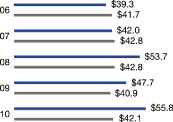
Net cash used in investing activities was $55.1 million in 2010, $48.0 million in 2009 and $50.0
million in 2008. Capital expenditures were $55.8 million in 2010, $47.7 million in 2009 and $53.7
million in 2008.
Net cash used in financing activities was $97.5 million in 2010, $80.4 million in 2009 and $38.4
million in 2008. The Company had net reductions in debt of $72.6 million in 2010, $54.5 million in
2009 and $21.6 million in 2008. In each of the last three years, the Company was able to finance
capital expenditures and dividend payments and still reduce debt levels. The Company maintains debt
levels it considers prudent based on its cash flows, interest coverage and percentage of total debt
to total capital.
Dividends
Paid Per Share

The Company has paid uninterrupted quarterly cash dividends since commencing public trading in its
stock in 1962. The Company’s quarterly dividend was 20 cents per share since the second quarter of
2010 when it was increased from 19 cents per share. Dividends paid per share were 79 cents in 2010,
76 cents in 2009 and 74 cents in 2008. Total dividends paid were $39.0 million, $37.0 million and
$35.6 million in 2010, 2009 and 2008, respectively.
With the exception of the increase in raw material costs discussed above, the impact of inflation
on both the Company’s financial position and its results of operations has been minimal and is not
expected to adversely affect 2011 results.
ISSUER PURCHASES OF EQUITY SECURITIES
There have been no purchases of Company stock in the last three years. On April 27, 2001, the
Board approved a share repurchase program under which the Company is authorized to repurchase up to
5.0 million shares of Company stock in addition to amounts remaining from prior Board
authorizations. As of December 31, 2010, 3.0 million shares were available to be repurchased under
existing authorizations. The Company’s share repurchase program has no expiration date.
CRITICAL ACCOUNTING POLICIES
In preparing the financial statements in accordance with accounting principles generally
accepted in the U.S., management is required to make estimates and assumptions that have an impact
on the asset, liability, revenue and expense amounts reported. These estimates can also affect
supplemental information disclosures of the Company, including information about contingencies,
risk and financial condition. The Company believes, given current facts and circumstances, that its
estimates and assumptions are reasonable, adhere to accounting principles generally accepted in the
U.S. and are consistently applied. Inherent in the nature of an estimate or assumption is the fact
that actual results may differ from estimates and estimates may vary as
23
Management’s Discussion & Analysis
of Operations & Financial Condition (continued)
of Operations & Financial Condition (continued)
new facts and circumstances arise. The Company makes routine estimates and judgments in
determining the net realizable value of accounts receivable, inventories, property, plant and
equipment, and prepaid expenses. Management believes the Company’s most critical accounting
estimates and assumptions are in the following areas:
Revenue Recognition The Company recognizes revenue (net of estimated discounts, allowances and
returns) when title passes, the customer is obligated to pay the Company and the Company has no
remaining obligations. Such recognition typically corresponds with the shipment of goods.
Goodwill Valuation The Company reviews the carrying value of goodwill annually utilizing several
valuation methodologies, including a discounted cash flow model. The Company completed its annual
goodwill impairment test under Accounting Standards Codification (“ASC”) 350, Intangibles –
Goodwill and Other, in the third quarter of 2010. In conducting its annual test for impairment, the
Company estimates the fair value for each of its reporting units and compares each of these values
to the net book value of each reporting unit. Fair value is estimated using both a discounted cash
flow analysis and an analysis of comparable company market values. If the fair value of a reporting
unit exceeds its net book value, no impairment exists. The Company has three reporting units that
had goodwill recorded and were tested for impairment. The Flavors and Fragrances reporting unit and
the Asia Pacific reporting unit had fair values that were over 100% above their respective net book
values. The fair value of the Color reporting unit had a fair value that was over 30% above its net
book value. Changes in estimates of future cash flows caused by items such as unforeseen events or
changes in market conditions could negatively affect the reporting units’ fair value and result in
an impairment charge.
Income Taxes The Company estimates its income tax expense in each of the taxing jurisdictions in
which it operates. The Company is subject to a tax audit in each of these jurisdictions, which
could result in changes to the estimated tax expense. The amount of these changes would vary by
jurisdiction and would be recorded when probable and estimable. These changes could impact the
Company’s financial statements. Management has recorded valuation allowances to reduce its deferred
tax assets to the amount that is more likely than not to be realized. Examples of deferred tax
assets include deductions, net operating losses and tax credits which the Company believes will
reduce its future tax payments. In assessing the future realization of these assets, management has
considered future taxable income and ongoing tax planning strategies. An adjustment to the recorded
valuation allowance as a result of changes in facts or circumstances could result in a significant
change in the Company’s tax expense. The Company does not provide for deferred taxes on unremitted
earnings of foreign subsidiaries which are considered to be invested indefinitely.
Commitments and Contingencies The Company is subject to litigation and other legal proceedings
arising in the ordinary course of its businesses or arising under provisions related to the
protection of the environment. Estimating liabilities and costs associated with these matters
requires the judgment of management, who rely in part on information from Company legal counsel.
When it is probable that the Company has incurred a liability associated with claims or pending or
threatened litigation matters and the Company’s exposure is reasonably estimable, the Company
records a charge against earnings. The Company recognizes related insurance reimbursement when
receipt is deemed probable. The Company’s estimate of liabilities and related insurance recoveries
may change as further facts and circumstances become known.
MARKET RISK FACTORS
The Company is exposed to market risks, including changes in interest rates, currency exchange
rates and commodity prices. To manage the volatility relating to these exposures on a consolidated
basis, the Company nets the exposures to take advantage of natural offsets. The Company also enters
into various derivative transactions for some of the remaining exposures pursuant to the Company’s
policies covering hedging practices. The financial impacts of these hedging instruments are offset
by corresponding changes in the underlying exposures being hedged.
24
Sensient Technologies Corporation Annual Report 2010
The Company does not hold or issue derivative financial instruments for trading purposes. Note
1 and Note 4 to the Consolidated Financial Statements include a discussion of the Company’s
accounting policies for financial instruments.
A key part of the Company’s strategy is to expand into new geographic markets. Because the Company
manufactures and sells its products throughout the world, it is exposed to movements in foreign
currency exchange rates. The major foreign currency exposures involve the markets in Western
Europe, Mexico and Canada. The primary purpose of the Company’s foreign currency hedging activities
is to protect against the volatility associated with foreign currency sales, purchases of
materials, and other assets and liabilities created during the normal course of business. The
Company generally utilizes foreign exchange contracts with durations of less than 12 months that
may or may not be designated as cash flow hedges under ASC 815, Derivatives and Hedging. At
December 31, 2010 and 2009, the net fair values of these instruments, based on dealer quotes, were
liabilities of $0.1 million and $0.3 million, respectively. At December 31, 2010 and 2009, the
potential gain or loss in the fair value of the Company’s outstanding foreign exchange contracts,
assuming a hypothetical 10% fluctuation in the currencies of such contracts, would be approximately
$1.1 million and $2.4 million, respectively. However, any change in the value of the contracts,
real or hypothetical, would be significantly offset by a corresponding change in the value of the
underlying hedged items. In addition, this hypothetical calculation assumes that each exchange rate
would change in the same direction relative to the U.S. dollar.
The Company has certain debt denominated in Swiss Francs and Euros. These non-derivative debt
instruments act as partial hedges of the Company’s Swiss Franc and Euro net asset positions. The
potential increase or decrease in the annual U.S. dollar interest expense of the Company’s
outstanding foreign currency-denominated debt, assuming a hypothetical 10% fluctuation in the
currencies of such debt, would be approximately $0.5 million and $0.6 million at December 31, 2010
and 2009, respectively. However, any change in interest expense from fluctuations in currency, real
or hypothetical, would be significantly offset by a corresponding change in the value of the
foreign income before interest. In addition, this hypothetical calculation assumes that each
exchange rate would change in the same direction relative to the U.S. dollar.
The Company manages its debt structure and interest rate risk through the use of fixed rate and
floating rate debt and through the use of derivatives. The Company’s primary exposure is to
interest rates in the U.S. and Western Europe. At December 31, 2010 and 2009, the potential
increase or decrease in annual interest expense, assuming a hypothetical 10% fluctuation in
interest rates of floating rate debt, would be approximately $0.2 million in both years.
The Company is the purchaser of certain commodities, such as corn, sugar, soybean meal and fruits.
The Company generally purchases these commodities based upon market prices that are established
with the vendor as part of the purchase process. In general, the Company does not use commodity
financial instruments to hedge commodity prices due to a high correlation between the commodity
cost and the ultimate selling price of the Company’s products. On occasion, the Company may enter
into non-cancelable forward purchase contracts, as deemed appropriate, to reduce the effect of
price fluctuations on future manufacturing requirements.
CONTRACTUAL OBLIGATIONS
The Company is subject to certain contractual obligations, including long-term debt, operating
leases, manufacturing purchases and pension benefit obligations. The Company has unrecognized tax
benefits of $9.4 million as of December 31, 2010. However, the Company cannot make a reasonably
reliable estimate of the period of potential cash settlement of the liabilities and, therefore, has
not included unrecognized tax benefits in the following table of significant contractual
obligations as of December 31, 2010.
25
Management’s Discussion & Analysis
of Operations & Financial Condition (continued)
of Operations & Financial Condition (continued)
| PAYMENTS DUE BY PERIOD | ||||||||||||||||||||
| (in thousands) | Total | 1 year | 2-3 years | 4-5 years | > 5 years | |||||||||||||||
Long-term debt |
$ | 324,360 | $ | 102,617 | $ | 119,651 | $ | 24,351 | $ | 77,741 | ||||||||||
Interest payments on long-term debt |
53,975 | 15,851 | 23,941 | 12,272 | 1,911 | |||||||||||||||
Operating lease obligations |
19,333 | 6,874 | 7,030 | 2,282 | 3,147 | |||||||||||||||
Manufacturing purchase commitments |
106,448 | 91,564 | 14,884 | — | — | |||||||||||||||
Pension funding obligations |
56,835 | 2,697 | 32,030 | 5,319 | 16,789 | |||||||||||||||
Total contractual obligations |
$ | 560,951 | $ | 219,603 | $ | 197,536 | $ | 44,224 | $ | 99,588 | ||||||||||
OFF-BALANCE SHEET ARRANGEMENTS
The Company had no off-balance sheet arrangements as of December 31, 2010.
FORWARD-LOOKING STATEMENTS
This document contains forward-looking statements that reflect management’s current assumptions and
estimates of future economic circumstances, industry conditions, Company performance and financial
results. Forward-looking statements include statements in the future tense, statements referring to
any period after December 31, 2010, and statements including the terms “expect,” “believe,”
“anticipate” and other similar terms that express expectations as to future events or conditions.
The Private Securities Litigation Reform Act of 1995 provides a safe harbor for such
forward-looking statements. Such forward-looking statements are not guarantees of future
performance and involve known and unknown risks, uncertainties and other factors that could cause
actual events to differ materially from those expressed in those statements. A variety of factors
could cause the Company’s actual results and experience to differ materially from the anticipated
results. These factors and assumptions include the pace and nature of new product introductions by
the Company’s customers; the Company’s ability to successfully implement its growth strategies; the
outcome of the Company’s various productivity-improvement and cost-reduction efforts; changes in
costs of raw materials and energy; industry and economic factors related to the Company’s domestic
and international business; competition from other suppliers of colors, flavors and fragrances;
growth or contraction in markets for products in which the Company competes; terminations and other
changes in customer relationships; industry acceptance of price increases; currency exchange rate
fluctuations; cost and availability of credit; and the matters discussed above including the
critical accounting policies described therein. The Company does not undertake to publicly update
or revise its forward-looking statements even if experience or future changes make it clear that
any projected results expressed or implied therein will not be realized.
26
| Consolidated Statements of Earnings | Sensient Technologies Corporation Annual Report 2010 |
| (in thousands except per share amounts) Years ended December 31, | 2010 | 2009 | 2008 | |||||||||
Revenue |
$ | 1,328,180 | $ | 1,201,412 | $ | 1,252,620 | ||||||
Cost of products sold |
919,821 | 832,382 | 871,754 | |||||||||
Selling and administrative expenses |
233,782 | 222,067 | 219,267 | |||||||||
Operating Income |
174,577 | 146,963 | 161,599 | |||||||||
Interest expense |
20,384 | 23,788 | 32,306 | |||||||||
Earnings Before Income Taxes |
154,193 | 123,175 | 129,293 | |||||||||
Income taxes |
47,049 | 36,614 | 38,432 | |||||||||
Net Earnings |
$ | 107,144 | $ | 86,561 | $ | 90,861 | ||||||
Earnings per share: |
||||||||||||
Basic |
$ | 2.18 | $ | 1.79 | $ | 1.91 | ||||||
Diluted |
$ | 2.17 | $ | 1.78 | $ | 1.89 | ||||||
Average common shares outstanding: |
||||||||||||
Basic |
49,138 | 48,379 | 47,654 | |||||||||
Diluted |
49,424 | 48,641 | 48,131 | |||||||||
See notes to consolidated financial statements.
27
Consolidated Balance Sheets
| (in thousands except share and per share amounts) December 31, | 2010 | 2009 | ||||||
Assets |
||||||||
Current Assets: |
||||||||
Cash and cash equivalents |
$ | 14,255 | $ | 12,219 | ||||
Trade accounts receivable, less allowance for losses of $3,999 and
$3,427, respectively |
218,614 | 200,186 | ||||||
Inventories |
392,166 | 390,011 | ||||||
Prepaid expenses and other current assets |
34,676 | 42,668 | ||||||
Deferred income taxes |
12,594 | 13,025 | ||||||
Total current assets |
672,305 | 658,109 | ||||||
Other assets |
36,093 | 38,349 | ||||||
Intangible assets — at cost, less accumulated amortization of $12,281
and $11,014, respectively |
13,219 | 13,621 | ||||||
Goodwill |
445,115 | 455,995 | ||||||
Property, Plant and Equipment: |
||||||||
Land |
49,760 | 49,429 | ||||||
Buildings |
293,605 | 293,200 | ||||||
Machinery and equipment |
648,985 | 630,420 | ||||||
Construction in progress |
32,797 | 20,211 | ||||||
| 1,025,147 | 993,260 | |||||||
Less accumulated depreciation |
(592,611 | ) | (567,643 | ) | ||||
| 432,536 | 425,617 | |||||||
Total assets |
$ | 1,599,268 | $ | 1,591,691 | ||||
Liabilities and Shareholders’ Equity |
||||||||
Current Liabilities: |
||||||||
Trade accounts payable |
$ | 95,852 | $ | 88,915 | ||||
Accrued salaries, wages and withholdings from employees |
26,822 | 22,568 | ||||||
Other accrued expenses |
49,819 | 64,789 | ||||||
Income taxes |
7,120 | 692 | ||||||
Short-term borrowings |
25,450 | 39,181 | ||||||
Current maturities of long-term debt |
— | — | ||||||
Total current liabilities |
205,063 | 216,145 | ||||||
Deferred income taxes |
21,034 | 12,810 | ||||||
Other liabilities |
12,279 | 14,393 | ||||||
Accrued employee and retiree benefits |
52,747 | 50,796 | ||||||
Long-term debt |
324,360 | 388,852 | ||||||
Shareholders’ Equity: |
||||||||
Common stock, par value $0.10 a share, authorized 100,000,000
shares; issued 53,954,874 shares |
5,396 | 5,396 | ||||||
Additional paid-in capital |
89,027 | 85,504 | ||||||
Earnings reinvested in the business |
991,094 | 922,963 | ||||||
Treasury stock, 4,345,712 and 5,182,710 shares, respectively, at cost |
(87,102 | ) | (103,878 | ) | ||||
Accumulated other comprehensive loss |
(14,630 | ) | (1,290 | ) | ||||
| 983,785 | 908,695 | |||||||
Total liabilities and shareholders’ equity |
$ | 1,599,268 | $ | 1,591,691 | ||||
See notes to consolidated financial statements.
28
| Consolidated Statements of Cash Flows | Sensient Technologies Corporation Annual Report 2010 |
| (in thousands) Years ended December 31, | 2010 | 2009 | 2008 | |||||||||
Cash Flows from Operating Activities |
||||||||||||
Net earnings |
$ | 107,144 | $ | 86,561 | $ | 90,861 | ||||||
Adjustments to arrive at net cash provided by operating activities: |
||||||||||||
Depreciation and amortization |
43,423 | 42,183 | 44,445 | |||||||||
Share-based compensation |
5,678 | 3,860 | 3,798 | |||||||||
Loss on assets |
1,382 | 1,819 | 1,358 | |||||||||
Deferred income taxes |
8,685 | (3,895 | ) | 3,329 | ||||||||
Changes in operating assets and liabilities: |
||||||||||||
Trade accounts receivable |
(20,229 | ) | 5,013 | (16,908 | ) | |||||||
Inventories |
(4,191 | ) | 1,190 | (40,591 | ) | |||||||
Prepaid expenses and other assets |
9,370 | (14,602 | ) | (672 | ) | |||||||
Accounts payable and other accrued expenses |
(7,757 | ) | 14,058 | (2,216 | ) | |||||||
Accrued salaries, wages and withholdings from employees |
5,053 | (1,557 | ) | 2,084 | ||||||||
Income taxes |
2,699 | 965 | 1,939 | |||||||||
Other liabilities |
4,468 | 2,741 | (453 | ) | ||||||||
Net cash provided by operating activities |
155,725 | 138,336 | 86,974 | |||||||||
Cash Flows from Investing Activities |
||||||||||||
Acquisition of property, plant and equipment |
(55,823 | ) | (47,716 | ) | (53,680 | ) | ||||||
Proceeds from sale of assets |
172 | 109 | 2,064 | |||||||||
Other investing activities |
528 | (440 | ) | 1,661 | ||||||||
Net cash used in investing activities |
(55,123 | ) | (48,047 | ) | (49,955 | ) | ||||||
Cash Flows from Financing Activities |
||||||||||||
Proceeds from additional borrowings |
139,344 | 222,553 | 112,514 | |||||||||
Debt payments |
(211,935 | ) | (277,064 | ) | (134,135 | ) | ||||||
Dividends paid |
(39,013 | ) | (37,042 | ) | (35,597 | ) | ||||||
Proceeds from options exercised and other equity transactions |
14,063 | 11,185 | 18,862 | |||||||||
Net cash used in financing activities |
(97,541 | ) | (80,368 | ) | (38,356 | ) | ||||||
Effect of exchange rate changes on cash and cash equivalents |
(1,025 | ) | (6,200 | ) | (687 | ) | ||||||
Net increase (decrease) in cash and cash equivalents |
2,036 | 3,721 | (2,024 | ) | ||||||||
Cash and cash equivalents at beginning of year |
12,219 | 8,498 | 10,522 | |||||||||
Cash and cash equivalents at end of year |
$ | 14,255 | $ | 12,219 | $ | 8,498 | ||||||
Cash paid during the year for: |
||||||||||||
Interest |
$ | 19,932 | $ | 26,982 | $ | 31,975 | ||||||
Income taxes |
32,668 | 36,801 | 28,424 | |||||||||
Capitalized interest |
810 | 840 | 1,999 | |||||||||
See notes to consolidated financial statements.
29
Consolidated Statements of Shareholders’ Equity
| Additional | ||||||||
| Common | Paid-in | |||||||
| (in thousands except share and per share amounts) | Stock | Capital | ||||||
Balances at December 31, 2007 |
$ | 5,396 | $ | 75,233 | ||||
Net earnings |
||||||||
Unrealized loss on cash flow hedges, arising during the period, net of tax of $13 |
||||||||
Reclassification adjustment for cash flow hedges included in net income, net of tax of $3 |
||||||||
Pension adjustment, net of tax of $1,473 |
||||||||
Foreign currency translation |
||||||||
Total comprehensive income |
||||||||
Cash dividends paid — $0.74 a share |
||||||||
Share-based compensation |
4,989 | |||||||
Stock options exercised |
2,511 | |||||||
Nonvested stock issued upon vesting |
(1,688 | ) | ||||||
Benefit plans |
173 | |||||||
Other |
1,043 | |||||||
Balances at December 31, 2008 |
5,396 | 82,261 | ||||||
Net earnings |
||||||||
Unrealized gain on cash flow hedges, arising during the period, net of tax of $118 |
||||||||
Reclassification adjustment for cash flow hedges included in net income, net of tax of $141 |
||||||||
Pension adjustment, net of tax of $3,329 |
||||||||
Foreign currency translation |
||||||||
Total comprehensive income |
||||||||
Cash dividends paid — $0.76 a share |
||||||||
Share-based compensation |
4,088 | |||||||
Stock options exercised |
901 | |||||||
Nonvested stock issued upon vesting |
(1,830 | ) | ||||||
Benefit plans |
34 | |||||||
Other |
50 | |||||||
Balances at December 31, 2009 |
5,396 | 85,504 | ||||||
Net earnings |
||||||||
Unrealized gain on cash flow hedges, arising during the period, net of tax of $90 |
||||||||
Reclassification adjustment for cash flow hedges included in net income, net of tax of $41 |
||||||||
Pension adjustment, net of tax of $504 |
||||||||
Foreign currency translation |
||||||||
Total comprehensive income |
||||||||
Cash dividends paid — $0.79 a share |
||||||||
Share-based compensation |
5,746 | |||||||
Stock options exercised |
1,365 | |||||||
Nonvested stock issued upon vesting |
(4,609 | ) | ||||||
Benefit plans |
184 | |||||||
Other |
837 | |||||||
Balances at December 31, 2010 |
$ | 5,396 | $ | 89,027 | ||||
See notes to consolidated financial statements.
30
Sensient Technologies Corporation Annual Report 2010
| Accumulated | ||||||||||||||||||||
| Earnings | Other | Total | ||||||||||||||||||
| Reinvested in | Treasury Stock | Comprehensive | Comprehensive | |||||||||||||||||
| the Business | Shares | Amount | Income (Loss) | Income | ||||||||||||||||
| $ | 818,180 | 6,603,650 | $ | (132,358 | ) | $ | 47,970 | |||||||||||||
| 90,861 | $ | 90,861 | ||||||||||||||||||
| (91 | ) | (91 | ) | |||||||||||||||||
| 18 | 18 | |||||||||||||||||||
| 3,574 | 3,574 | |||||||||||||||||||
| (77,759 | ) | (77,759 | ) | |||||||||||||||||
| $ | 16,603 | |||||||||||||||||||
| (35,597 | ) | |||||||||||||||||||
| 59,400 | (1,191 | ) | ||||||||||||||||||
| (759,241 | ) | 15,217 | ||||||||||||||||||
| (84,200 | ) | 1,688 | ||||||||||||||||||
| (21,312 | ) | 427 | ||||||||||||||||||
| 873,444 | 5,798,297 | (116,217 | ) | (26,288 | ) | |||||||||||||||
| 86,561 | $ | 86,561 | ||||||||||||||||||
| 826 | 826 | |||||||||||||||||||
| (987 | ) | (987 | ) | |||||||||||||||||
| (6,136 | ) | (6,136 | ) | |||||||||||||||||
| 31,295 | 31,295 | |||||||||||||||||||
| $ | 111,559 | |||||||||||||||||||
| (37,042 | ) | |||||||||||||||||||
| 11,400 | (228 | ) | ||||||||||||||||||
| (502,167 | ) | 10,065 | ||||||||||||||||||
| (91,300 | ) | 1,830 | ||||||||||||||||||
| (33,520 | ) | 672 | ||||||||||||||||||
| 922,963 | 5,182,710 | (103,878 | ) | (1,290 | ) | |||||||||||||||
| 107,144 | $ | 107,144 | ||||||||||||||||||
| 628 | 628 | |||||||||||||||||||
| (284 | ) | (284 | ) | |||||||||||||||||
| 910 | 910 | |||||||||||||||||||
| (14,594 | ) | (14,594 | ) | |||||||||||||||||
| $ | 93,804 | |||||||||||||||||||
| (39,013 | ) | |||||||||||||||||||
| 3,400 | (68 | ) | ||||||||||||||||||
| (582,174 | ) | 11,668 | ||||||||||||||||||
| (229,951 | ) | 4,609 | ||||||||||||||||||
| (28,273 | ) | 567 | ||||||||||||||||||
| $ | 991,094 | 4,345,712 | $ | (87,102 | ) | $ | (14,630 | ) | ||||||||||||
31
Notes to Consolidated Financial Statements
Years ended December 31, 2010, 2009 and 2008
Years ended December 31, 2010, 2009 and 2008
1.
Summary of Significant
Accounting Policies
Summary of Significant
Accounting Policies
Principles of Consolidation and Basis of Presentation The consolidated financial statements
include the accounts of Sensient Technologies Corporation and its subsidiaries (the “Company”). All
significant intercompany accounts and transactions are eliminated.
Sensient Technologies Corporation is a leading global manufacturer and marketer of colors, flavors
and fragrances. The Company uses advanced technologies at facilities around the world to develop
specialty food and beverage systems, cosmetic and pharmaceutical
systems, inkjet and specialty inks
and colors and other specialty chemicals. The Company’s reportable segments consist of the Flavors
& Fragrances and Color Groups, which are managed on a products and services basis. The Asia Pacific
and China Groups, which are managed on a geographic basis, are included in Corporate and Other.
Use of Estimates The preparation of the consolidated financial statements in conformity with
accounting principles generally accepted in the United States of America requires management to
make estimates and assumptions that affect reported amounts of assets, liabilities, revenue and
expenses during the reporting period and the disclosure of contingent assets and liabilities at the
date of the financial statements. Actual results could differ from those estimates.
Revenue Recognition The Company recognizes revenue (net of estimated discounts, allowances and
returns) when title of goods passes, the customer is obligated to pay the Company and the Company
has no remaining obligations. Such recognition typically corresponds with the shipment of goods.
Cost of Products Sold Cost of products sold includes materials, labor and overhead expenses
incurred in the manufacture of our products. Cost of products sold also includes charges for
obsolete and slow moving inventories, as well as costs for quality control, purchasing and
receiving costs, inspection costs, warehousing costs, internal transfer costs, other costs of our
internal distribution network and costs incurred for shipping and handling. The Company records
fees billed to customers for shipping and handling as revenue.
Selling and Administrative Expenses Selling and administrative expenses primarily include the
salaries and related costs for executive, finance, accounting, human resources, information
technology, research and development and legal personnel as well as salaries and related costs of
salespersons and commissions paid to external sales agents.
Cash Equivalents The Company considers all highly liquid investments with maturities of three
months or less at the date of acquisition as cash equivalents.
Accounts Receivable Receivables are recorded at their face amount, less an allowance for doubtful
accounts. The allowance for doubtful accounts is based on customer-specific analysis and general
matters such as current assessments of past due balances and economic conditions. Specific accounts
are written off against the allowance for doubtful accounts when it is deemed that the receivable
is no longer collectible.
Inventories Inventories are stated at the lower of cost or market. Market is determined on the
basis of estimated realizable values. Cost is determined using the first-in, first-out (“FIFO”)
method with the exception of certain locations of the Flavors & Fragrances Group where cost is
determined using a weighted average method. Inventories include finished and in-process products
totaling $261.6 million and $275.5 million at December 31, 2010 and 2009, respectively, and raw
materials and supplies of $130.6 million and $114.5 million at December 31, 2010 and 2009,
respectively.
Property, Plant and Equipment Property, plant and equipment are recorded at cost reduced by
accumulated depreciation. Depreciation is provided over the estimated useful life of the related
asset using the straight-line method for financial reporting. The estimated useful lives for
buildings and leasehold improvements range from 5 to 40 years. Machinery and equipment have useful
lives ranging from 3 to 20 years. Interest costs on significant projects constructed or developed
for the Company’s own use are capitalized as part of the asset.
Goodwill and Other Intangible Assets The carrying value of goodwill and other intangible assets
with indefinite lives is evaluated for impairment on an annual basis or when an indicator of
impairment occurs. The impairment assessment includes comparing the carrying amount of net assets,
including goodwill, of each reporting unit to its respective fair value as of the date of the
assessment. Fair value was estimated based upon an evaluation of the reporting unit’s estimated
future discounted cash flow as well as the public trading and private transaction valuation
multiples for comparable companies. Such determination of fair value yielded no impairment in 2010,
2009 or 2008.
The cost of intangible assets with determinable useful lives is amortized on a straight-line basis
to reflect the pattern of economic benefits consumed, ranging from 5 to 20 years. These assets
include technological know-how, customer relationships, patents, trademarks and non-compete
agreements, among others.
32
Sensient Technologies Corporation Annual Report 2010
Impairment of Long-lived Assets The Company reviews long-lived assets for impairment whenever
events or changes in business circumstances indicate that the carrying amount of the assets may not
be fully recoverable. The Company performs undiscounted cash flow analyses to determine if
potential impairment exists. If impairment is determined to exist, any related impairment loss is
calculated based on the difference between fair value and carrying value.
Financial Instruments The Company may use derivative financial instruments for the purpose of
hedging currency and interest rate exposures which exist as part of ongoing business operations. As
a policy, the Company does not engage in speculative or leveraged transactions, nor does the
Company hold or issue financial instruments for trading purposes.
Hedge effectiveness is determined by how closely the changes in the fair value of the hedging
instrument offset the changes in the fair value or cash flows of the hedged item. Hedge accounting
is permitted only if the hedging relationship is expected to be highly effective at the inception
of the transaction and on an ongoing basis. Any ineffective portions are recognized in earnings
immediately.
Interest Rate Hedging The Company is exposed to interest rate risk through its corporate borrowing
activities. The objective of the Company’s interest rate risk management activities is to manage
the levels of the Company’s fixed and floating interest rate exposure to be consistent with the
Company’s preferred mix. The interest rate risk management program may include entering into
interest rate swaps, which qualify as fair value hedges, when there is a desire to modify the
Company’s exposure to interest rates. Gains or losses on fair value hedges are recognized in
earnings, net of gains and losses on the fair value of the hedged instruments.
Cash Flow Hedges The primary objectives of the foreign exchange risk management activities are to
understand and mitigate the impact of potential foreign exchange fluctuations on the Company’s
financial results and its economic well-being. Generally, these risk management transactions
involve the use of foreign currency derivatives to protect against exposure resulting from recorded
accounts receivable and payable. The Company may utilize forward exchange contracts, generally with
maturities of less than 12 months, which qualify as cash flow hedges. These foreign exchange
contracts are intended to offset the effect of exchange rate fluctuations on recorded intercompany
receivables and payables. Gains and losses on these instruments are deferred in accumulated other
comprehensive (loss) income (“OCI”) until the underlying transaction is recognized in earnings.
The Company’s existing cash flow hedges are highly effective. As a result, any current impact on
earnings due to cash flow hedge ineffectiveness is immaterial.
Net Investments Hedging The Company may enter into foreign-denominated debt to be used as a
non-derivative instrument to hedge the Company’s net investment in foreign subsidiaries. The change
in the carrying amount of the foreign-denominated debt on the Company’s books, attributable to
changes in the spot foreign exchange rate, is a hedge of the net investment in its foreign
subsidiaries. Changes in the fair value of debt designated as a net investment hedge are recorded
in foreign currency translation in OCI.
Commodity Purchases The Company purchases certain commodities in the normal course of business that
result in physical delivery of the goods and, hence, are excluded from Accounting Standards
Codification (“ASC”) 815, Derivatives and Hedging.
Translation of Foreign Currencies For all significant foreign operations, the functional currency
is the local currency. Assets and liabilities of foreign operations are translated into U.S.
dollars at current exchange rates. Revenue and expense accounts are translated into U.S. dollars at
average exchange rates prevailing during the year. Adjustments resulting from the translation of
foreign accounts into U.S. dollars are recorded in foreign currency translation in OCI. Transaction
gains and losses that occur as a result of transactions denominated in non-functional currencies
are included in earnings and were not significant during the three-year period ended December 31,
2010.
Share-Based Compensation Share-based compensation expense is recognized on a straight line basis
over the vesting period of each award recipient. See Note 5, Share-Based Compensation, for
additional information.
Income Taxes The Company recognizes a current tax liability or asset for the estimated taxes
payable or refundable on tax returns for the current year and a deferred tax liability or asset for
the estimated future tax effects attributable to temporary differences and carryforwards. The
measurement of current and deferred tax liabilities and assets is based on provisions of enacted
tax law. Deferred tax assets are reduced, if necessary, by the amount of any tax benefits for which
the utilization of the asset is not considered likely.
33
Notes to Consolidated Financial Statements (CONTINUED)
Years ended December 31, 2010, 2009 and 2008
Years ended December 31, 2010, 2009 and 2008
Earnings Per Share. The difference between basic and diluted EPS is the dilutive effect
of stock options and nonvested stock. Diluted EPS assumes that nonvested stock has vested and all
dilutive stock options, for which the average market price exceeds the exercise price
(in-the-money), are exercised. Stock options for which the exercise price exceeds the average
market price (out-of-the-money) have an anti-dilutive effect on EPS, and accordingly, are excluded
from the calculation. Weighted-average common shares for the computation of EPS were:
| (in thousands) | 2010 | 2009 | 2008 | |||||||||
Basic weighted-average shares outstanding |
49,138 | 48,379 | 47,654 | |||||||||
Diluted weighted-average shares
outstanding |
49,424 | 48,641 | 48,131 | |||||||||
For the years 2010, 2009 and 2008, options for 0.01 million shares, 0.2 million shares and 0.1
million shares, respectively, with weighted-average exercise prices of $30.07, $24.11 and $26.52,
respectively, were excluded from the diluted EPS calculation because their exercise prices were
greater than the average market price of the common stock and their inclusion in the calculation
would have been anti-dilutive. All earnings per share amounts are presented on a diluted basis
unless otherwise noted.
Accumulated Other Comprehensive (Loss) Income
Accumulated OCI is composed primarily of foreign
currency translation, minimum pension liability and unrealized
gains or losses on cash flow hedges. The components of OCI at December 31 were:
| (in thousands) | 2010 | 2009 | ||||||
Foreign currency translation |
$ | (1,475 | ) | $ | 13,140 | |||
Pension liability (net of tax) |
(13,324 | ) | (14,255 | ) | ||||
Unrealized gain (loss) on cash flow hedges
(net of tax) |
169 | (175 | ) | |||||
Accumulated other comprehensive loss |
$ | (14,630 | ) | $ | (1,290 | ) | ||
Research and Development Research and development costs are recorded in selling and
administrative expenses in the year they are incurred. Research and development costs were $30.6
million, $29.3 million and $28.3 million during the years ended December 31, 2010, 2009 and 2008,
respectively.
Advertising Advertising costs are recorded in selling and administrative expenses as they are
incurred. Advertising costs were $1.5 million, $1.1 million and $1.3 million during the years ended
December 31, 2010, 2009 and 2008, respectively.
Environmental Liabilities The Company records liabilities related to environmental remediation
obligations when estimated future expenditures are probable and reasonably estimable. Such accruals
are adjusted as further information becomes available or as circumstances change. Estimated future
expenditures are discounted to their present value when the timing and amount of future cash flows
are fixed and readily determinable. Recoveries of remediation costs from other parties, if any, are
recognized as assets when their receipt is assured.
Subsequent Events The Company performed an evaluation of subsequent events through the date these
financial statements were issued.
2.
Goodwill and Intangible Assets
At December 31, 2010 and 2009, the Company does not have any intangible assets other than
goodwill that are not subject to amortization. The following table summarizes intangible assets
with determinable useful lives by major category as of December 31, 2010 and 2009:
| Weighted Average | 2010 | 2009 | ||||||||||||||||||
| (in thousands except weighted | Amortization | Accumulated | Accumulated | |||||||||||||||||
| average amortization years) | Years | Cost | Amortization | Cost | Amortization | |||||||||||||||
Technological know-how |
20.0 | $ | 8,840 | $ | (4,242 | ) | $ | 8,609 | $ | (3,744 | ) | |||||||||
Customer relationships |
20.0 | 7,222 | (3,078 | ) | 7,185 | (2,690 | ) | |||||||||||||
Patents, trademarks, non-compete
agreements and other |
17.5 | 9,438 | (4,961 | ) | 8,841 | (4,580 | ) | |||||||||||||
Total finite-lived intangibles |
19.1 | $ | 25,500 | $ | (12,281 | ) | $ | 24,635 | $ | (11,014 | ) | |||||||||
34
Sensient Technologies Corporation Annual Report 2010
Amortization of intangible assets was $1.3 million, $1.3 million and $1.6 million in 2010, 2009
and 2008, respectively. Estimated amortization expense each year for the five years subsequent to
December 31, 2010, is $1.1 million in each year from 2011 through 2015.
The changes in goodwill for the years ended December 31, 2010 and 2009, by reportable business
segment, were as follows:
| Flavors & | Corporate | |||||||||||||||
| (in thousands) | Fragrances | Color | & Other | Consolidated | ||||||||||||
Balance as of December 31, 2008 |
$ | 131,942 | $ | 304,781 | $ | 3,693 | $ | 440,416 | ||||||||
Currency translation impact |
7,149 | 8,472 | (42 | ) | 15,579 | |||||||||||
Balance as of December 31, 2009 |
139,091 | 313,253 | 3,651 | 455,995 | ||||||||||||
Currency translation impact |
(2,699 | ) | (8,638 | ) | 457 | (10,880 | ) | |||||||||
Balance as of December 31, 2010 |
$ | 136,392 | $ | 304,615 | $ | 4,108 | $ | 445,115 | ||||||||
3.
Debt
Long-term Debt Long-term debt
consisted of the following unsecured
obligations at December 31:
| (in thousands) | 2010 | 2009 | ||||||
4.91% senior notes due through May 2017 |
$ | 110,000 | $ | — | ||||
5.85% Euro-denominated senior notes due November 2013 |
25,876 | 27,689 | ||||||
7.31% senior notes due November 2013 |
25,000 | 25,000 | ||||||
5.78% Euro-denominated senior notes due November 2011 |
51,753 | 55,377 | ||||||
7.17% senior notes due November 2011 |
30,000 | 30,000 | ||||||
Floating rate Euro-denominated senior notes |
— | 27,689 | ||||||
6.68% senior notes due through January 2011 |
2,143 | 4,286 | ||||||
6.77% senior notes due through January 2010 |
— | 15,000 | ||||||
Floating rate term loan due June 2012 |
46,625 | 99,750 | ||||||
Long-term revolving loan agreement |
28,871 | 98,912 | ||||||
Various other notes |
4,092 | 5,149 | ||||||
| 324,360 | 388,852 | |||||||
Less current maturities |
— | — | ||||||
Total long-term debt |
$ | 324,360 | $ | 388,852 | ||||
In March 2009, the Company borrowed $105 million under a senior unsecured term loan
agreement (“Term Loan”) with a group of five banks. The Term Loan matures on June 15, 2012, and the
interest rate on the Term Loan is based on floating rates at the Company’s election of either (1)
the higher of (a) the prime rate or (b) the federal funds rate plus 0.5% or (2) a Eurodollar base
rate derived from LIBOR plus a margin (initially 225 basis points but subject to adjustment as the
Company’s leverage ratio changes). The Company may prepay the Term Loan in whole or in part prior
to the maturity date without any penalty.
In November 2009, the Company entered into an agreement to issue U.S. dollar denominated debt
totaling $110
million through a private placement of notes with a group of four financial institutions. These
notes were issued in May 2010 and have a fixed coupon rate of 4.91% with a final maturity date of
May 2017. Proceeds from the sale of the notes have been used to repay existing indebtedness and for
general corporate purposes.
The Company has a $300 million multi-currency revolving credit facility with a group of seven
banks. This credit facility matures in June 2012 and is unsecured. Interest rates on borrowings
with three days notice are determined based upon LIBOR plus a margin subject to adjustment based on
the Company’s debt to EBITDA ratio, as defined, or the rating accorded the Company’s senior debt by
Standard & Poor’s and Moody’s, which-
35
Notes to Consolidated Financial Statements (CONTINUED)
Years ended December 31, 2010, 2009 and 2008
Years ended December 31, 2010, 2009 and 2008
ever is more favorable to the Company. Without three days notice, interest is based on
the higher of the prime rate or the federal funds rate plus 0.50%.
The Company’s floating rate long-term Euro-denominated notes, which were paid off on May 28, 2010,
had average coupon rates of 2.58% and 3.62% for the years ended December 31, 2010 and 2009,
respectively. The borrowings under the long-term revolving loan agreement had an average interest
rate of 0.65% and 0.85% for the year ended December 31, 2010 and 2009, respectively. The
borrowings under the Term Loan had an average interest rate of 2.35% and 2.57% for the years ended
December 31, 2010 and 2009, respectively.
The aggregate amounts of contractual maturities on long-term debt each year for the five years
subsequent to December 31, 2010, are as follows: 2011, $102.6 million; 2012, $57.4 million; 2013,
$62.2 million; 2014, $11.3 million; and 2015, $13.0 million.
The Company has approximately $102.6 million of long-term debt that matures in 2011. It is the
Company’s intention to refinance these maturities under the long-term revolving loan agreement and,
accordingly, that maturing debt has been classified as long-term debt in the Consolidated Balance
Sheet.
The Company has $264.7 million available under the revolving credit facility and $32.5 million
available under other lines of credit from several banks at December 31, 2010.
Substantially all of the senior loan agreements contain restrictions concerning interest coverage,
borrowings, investments and tangible net worth amounts. The Company is in compliance with all of
these restrictions at December 31, 2010. The following table summarizes the Company’s most
restrictive loan covenants calculated in accordance with the applicable agreements as of December 31, 2010:
| (dollars in thousands) | Actual | Required | ||||||
Debt to Capital (Maximum) |
26.3 | % | 60.0 | % | ||||
Debt to EBITDA (Maximum) |
1.64 | 3.50 | ||||||
Net Worth (Minimum) |
$ | 983,785 | $ | 625,000 | ||||
Interest Coverage (Minimum) |
5.98 | 2.00 | ||||||
The Company has stand-by letters of credit outstanding of $6.4 million and $5.9 million as of
December 31, 2010 and 2009, respectively.
Short-term Borrowings The Company’s short-term borrowings consisted of the following items at
December 31:
| (in thousands) | 2010 | 2009 | ||||||
Direct borrowings under the
revolving loan agreement |
$ | — | $ | 25,000 | ||||
Uncommitted loans |
20,476 | 11,590 | ||||||
Loans of foreign subsidiaries |
4,974 | 2,591 | ||||||
Total |
$ | 25,450 | $ | 39,181 | ||||
The weighted-average interest rates on short-term borrowings were 2.39% and 1.48% at December 31,
2010 and 2009, respectively.
4.
Derivative Instruments and
Hedging Activity
Hedging Activity
The Company may use derivative instruments for the purpose of hedging currency, commodity and
interest rate exposures, which exist as part of ongoing business operations. As a policy, the
Company does not engage in speculative or leveraged transactions, nor does the Company hold or
issue financial instruments for trading purposes. Hedge effectiveness is determined by how closely
the changes in the fair value of the hedging instrument offset the changes in the fair value or
cash flows of the hedged transaction. Hedge accounting, which generally results in the deferral of
derivative gains and losses until such time as the underlying transaction is recognized in net
earnings, is permitted only if the hedging relationship is expected to be highly effective at the
inception of the transaction and on an ongoing basis. Any ineffective portions are recognized in
earnings immediately.
36
Sensient Technologies Corporation Annual Report 2010
The Company manages its exposure to foreign exchange risk by the use of forward exchange
contracts and foreign currency denominated debt to reduce the effect of fluctuating foreign
currencies on short-term foreign currency denominated intercompany transactions, non-functional
currency raw material purchases, non-functional currency sales and other known foreign currency
exposures. These derivatives may or may not be designated as hedges under ASC 815, Derivatives and
Hedging. These forward exchange contracts generally have maturities of less than twelve months. The
Company’s primary hedging activities and their accounting treatment are summarized below:
Forward Contracts Designated as Cash Flow Hedges The forward exchange contracts that have been
designated as hedges are accounted for as cash flow hedges. The Company had $10.1 million and $6.3
million of forward exchange contracts, designated as hedges, outstanding as of December 31, 2010
and 2009, respectively. The fair value of these forward exchange contracts was a liability of $0.1
million classified in Other liabilities in the Company’s Consolidated Balance Sheets as of both
December 31, 2010 and 2009. The gains or losses on these instruments are deferred in OCI until the
underlying transaction is recognized in net earnings. As of December 31, 2010, a gain of $0.2
million was deferred in OCI in the Company’s Consolidated Balance Sheet. For the periods ended
December 31, 2010 and 2009, gains of $0.3 million and $1.1 million, respectively, were reclassified
into net earnings in the Company’s Consolidated Statement of Earnings that offset the earnings
impact of the related non-functional asset or liability hedged in the same period. Over the next
twelve months, the Company expects to reclassify a gain of $0.2 million from OCI into net earnings.
Forward Contracts not Designated as Cash Flow Hedges The Company also utilizes forward exchange
contracts that are not designated as cash flow hedges under ASC 815. These contracts are
marked-to-market in net earnings immediately, at the same time as the non-functional asset or
liability is marked-to-market in net earnings. The results of these transactions are not material
to the financial statements for the years ended December 31, 2010, 2009 and 2008.
Net Investment Hedges The Company has certain debt denominated in Euros and Swiss Francs. These
debt instruments have been designated as partial hedges of the Company’s Euro and Swiss Franc net
asset positions. Changes in the fair value of this debt attributable to changes in the spot foreign exchange
rate are recorded in foreign currency translation in OCI. As of December 31, 2010 and 2009, the
total value of the Company’s Euro and Swiss Franc debt was $106.5 million and $141.7 million,
respectively. For the years ended December 31, 2010 and 2009, the impact of foreign exchange rates
on these debt instruments has decreased debt by $6.0 million and increased debt by $3.6 million,
respectively, and these amounts have been recorded as foreign currency translation in OCI.
Concentrations of Credit Risk Counterparties to forward exchange contracts consist of large
international financial institutions. While these counterparties may expose the Company to
potential losses due to the credit risk of non-performance, losses are not anticipated.
Concentrations of credit risk with respect to trade accounts receivable are limited by the large
number of customers, generally short payment terms and their dispersion across geographic areas.
5.
Share-Based Compensation
The Company has various stock plans under which employees and directors may be granted nonvested
stock, non-qualified stock options or incentive stock options. Upon vesting, the stock options
allow the participant to purchase common stock at 100% of the market price on the day the options
were granted. No options were granted in 2010 or 2009.
As of December 31, 2010, there were 1.8 million shares available to be granted as future stock
options and non-vested stock under existing stock plans. Of the shares available, 1.1 million may
be awarded as nonvested stock. Stock options become exercisable over a three-year vesting period,
or earlier upon retirement, and expire 10 years from the date of grant. Expense for stock options
is recognized on a straight-line basis over three years from the date of grant or over the period
from the date of grant until the participant is retirement-eligible, whichever is less. Treasury
shares are issued for nonvested stock awards and for the exercise of stock options.
37
Notes to Consolidated Financial Statements (CONTINUED)
Years ended December 31, 2010, 2009 and 2008
Years ended December 31, 2010, 2009 and 2008
The following table summarizes the transactions involving the stock option plans:
| Weighted- | Weighted- | |||||||||||||||
| (in thousands | Average | Average | Aggregate | |||||||||||||
| except exercise | Exercise | Remaining | Intrinsic | |||||||||||||
| price and life) | Options | Price | Life (Years) | Value | ||||||||||||
Outstanding at
December 31, 2007 |
2,228 | $ | 21.10 | 5.3 | $ | 16,008 | ||||||||||
Granted |
14 | 30.07 | ||||||||||||||
Exercised |
(759 | ) | 21.09 | |||||||||||||
Cancelled |
(33 | ) | 21.64 | |||||||||||||
Outstanding at
December 31, 2008 |
1,450 | 21.17 | 5.0 | 4,110 | ||||||||||||
Exercised |
(502 | ) | 19.34 | |||||||||||||
Cancelled |
(38 | ) | 22.58 | |||||||||||||
Outstanding at
December 31, 2009 |
910 | 22.13 | 4.4 | 3,852 | ||||||||||||
Exercised |
(582 | ) | 22.16 | |||||||||||||
Outstanding at
December 31, 2010 |
328 | $ | 22.06 | 3.9 | $ | 4,807 | ||||||||||
Exercisable at
December 31, 2010 |
323 | $ | 21.95 | 3.8 | $ | 4,776 | ||||||||||
The aggregate intrinsic values of stock options exercised during 2010, 2009 and 2008, were $3.9
million, $2.5 million and $6.5 million, respectively.
As of December 31, 2010, total remaining unearned compensation, net of expected forfeitures,
related to unvested stock options was $0.01 million, which will be amortized over the
weighted-average remaining service period of 0.3 years.
The following table summarizes information concerning outstanding and exercisable stock options at
December 31, 2010:
| Range of Exercise Price | ||||||||||||
| (in thousands except | $18.00- | $19.71- | $23.00- | |||||||||
| life and exercise price) | 19.70 | 22.99 | 30.07 | |||||||||
Options outstanding |
80 | 73 | 175 | |||||||||
Weighted-average remaining
contractual life, in years |
3.5 | 2.9 | 4.5 | |||||||||
Weighted-average exercise price |
$ | 18.78 | $ | 20.53 | $ | 24.19 | ||||||
Options exercisable |
80 | 73 | 170 | |||||||||
Weighted-average exercise price |
$ | 18.78 | $ | 20.53 | $ | 24.03 | ||||||
The Company’s stock plans also provide for the awarding of nonvested stock. Expense for shares
of nonvested stock is recognized over five years from the date of grant or during the period from
the date of grant until the participant attains age 65, whichever is less. During the period of
restriction, the holder of nonvested stock has voting rights and is entitled to receive all
dividends and other distributions paid with respect to the stock. The Company expenses awards for
nonvested stock based on the fair value of the Company’s common stock at the date of the grant.
The following table summarizes the nonvested stock activity:
| Grant Date | ||||||||||||
| Weighted- | Aggregate | |||||||||||
| (in thousands | Average | Intrinsic | ||||||||||
| except fair value) | Shares | Fair Value | Value | |||||||||
Outstanding at
December 31, 2007 |
451 | $ | 24.22 | $ | 12,764 | |||||||
Granted |
266 | 23.02 | ||||||||||
Vested |
(129 | ) | 21.33 | |||||||||
Cancelled |
(134 | ) | 23.93 | |||||||||
Outstanding at
December 31, 2008 |
454 | 24.42 | 10,847 | |||||||||
Granted |
235 | 24.78 | ||||||||||
Vested |
(131 | ) | 24.66 | |||||||||
Cancelled |
(134 | ) | 24.76 | |||||||||
Outstanding at
December 31, 2009 |
424 | 24.44 | 11,142 | |||||||||
Granted |
265 | 34.45 | ||||||||||
Vested |
(259 | ) | 27.92 | |||||||||
Cancelled |
(67 | ) | 24.79 | |||||||||
Outstanding at
December 31, 2010 |
363 | $ | 29.20 | $ | 13,340 | |||||||
38
Sensient Technologies Corporation Annual Report 2010
The total intrinsic values of shares vested during 2010, 2009 and 2008, was $9.2 million,
$3.3 million and $3.0 million, respectively.
As of December 31, 2010, total remaining unearned compensation, net of expected forfeitures,
related to nonvested stock was $8.9 million, which will be amortized over the weighted-average
remaining service period of 2.9 years.
Total pre-tax share-based compensation recognized in the Consolidated Statements of Earnings was
$5.7 million, $3.9 million and $3.8 million in 2010, 2009 and 2008, respectively. Tax related
benefits of $0.7 million, $0.5 million and $0.7 million were also recognized in 2010, 2009 and
2008, respectively. Cash received from the exercise of stock options was $12.9 million, $9.7
million and $16.0 million for 2010, 2009 and 2008, respectively, and is reflected in cash flows
from financing activities in the Consolidated Statements of Cash Flows.
6.
Retirement Plans
The Company provides benefits under defined contribution plans including a savings plan and an
employee stock ownership plan (“ESOP”). The savings plan covers substantially all domestic salaried
and certain non-union hourly employees and provides for matching contributions up to 4% of each
employee’s salary. The ESOP covers substantially all domestic employees and provides for
contributions based on a percentage of each employee’s compensation as determined by the Board of
Directors. Total expense for the Company’s defined contribution plans was $3.5 million, $3.8
million and $3.9 million in 2010, 2009 and 2008, respectively.
Although the Company intends for these defined contribution plans to be the primary retirement
benefit for most employees, the Company also has several defined benefit plans. The funded status
of the defined benefit plans was as follows at December 31:
| (in thousands) | 2010 | 2009 | ||||||
Benefit obligation at beginning of year |
$ | 58,142 | $ | 42,478 | ||||
Service cost |
1,896 | 1,285 | ||||||
Interest cost |
2,902 | 2,961 | ||||||
Plan amendments |
1,099 | 2,728 | ||||||
Foreign currency exchange rate changes |
178 | 1,826 | ||||||
Benefits paid |
(2,665 | ) | (2,268 | ) | ||||
Actuarial loss |
2,238 | 9,132 | ||||||
Benefit obligation at end of year |
63,790 | 58,142 | ||||||
Plan assets at beginning of year |
22,720 | 17,465 | ||||||
Company contributions |
3,873 | 3,728 | ||||||
Foreign currency exchange rate changes |
231 | 1,946 | ||||||
Benefits paid |
(2,665 | ) | (2,268 | ) | ||||
Actual gain on plan assets |
1,870 | 1,849 | ||||||
Plan assets at end of year |
26,029 | 22,720 | ||||||
Funded status |
$ | (37,761 | ) | $ | (35,422 | ) | ||
Accumulated benefit obligation |
$ | 59,903 | $ | 54,675 | ||||
Amounts recognized in the Consolidated Balance Sheets at December 31:
| (in thousands) | 2010 | 2009 | ||||||
Accrued employee and retiree benefits |
$ | (45,265 | ) | $ | (41,057 | ) | ||
Prepaid expenses and other current assets |
7,504 | 5,635 | ||||||
Net liability |
$ | (37,761 | ) | $ | (35,422 | ) | ||
Components of annual benefit cost:
| (in thousands) | 2010 | 2009 | 2008 | |||||||||
Service cost |
$ | 1,896 | $ | 1,285 | $ | 1,267 | ||||||
Interest cost |
2,902 | 2,961 | 2,922 | |||||||||
Expected return on plan assets |
(1,367 | ) | (1,103 | ) | (1,264 | ) | ||||||
Amortization of prior service cost |
3,011 | 1,824 | 1,950 | |||||||||
Recognized actuarial loss |
1,252 | 166 | 175 | |||||||||
Settlement expense |
— | — | 710 | |||||||||
Defined benefit expense |
$ | 7,694 | $ | 5,133 | $ | 5,760 | ||||||
Weighted-average liability assumptions as of December 31:
| 2010 | 2009 | |||||||
Discount rate |
4.35 | % | 5.04 | % | ||||
Expected return on plan assets |
5.80 | % | 6.06 | % | ||||
Rate of compensation increase |
4.27 | % | 4.38 | % | ||||
39
Notes to Consolidated Financial Statements (CONTINUED)
Years ended December 31, 2010, 2009 and 2008
Years ended December 31, 2010, 2009 and 2008
Weighted-average cost assumptions for the year ended December 31:
| 2010 | 2009 | |||||||
Discount rate |
5.04 | % | 6.83 | % | ||||
Expected return on plan assets |
6.06 | % | 5.96 | % | ||||
Rate of compensation increase |
4.38 | % | 4.28 | % | ||||
The aggregate amounts of benefits expected to be paid from defined benefit plans in each of the
next five years subsequent to December 31, 2010, which include employees’ expected future service
are as follows: 2011, $2.7 million; 2012, $11.9 million; 2013, $20.1 million; 2014, $3.2 million;
2015, $2.2 million; and $16.8 million in total for the years 2016 through 2020.
The Company expects to contribute $4.5 million to defined benefit plans in 2011.
Amounts recognized in accumulated other comprehensive loss were as follows:
| (in thousands) | 2010 | 2009 | ||||||
Prior service cost |
$ | 6,445 | $ | 8,349 | ||||
Unrecognized net actuarial loss |
14,741 | 14,250 | ||||||
The estimated prior service cost and actuarial loss for the defined benefit plans that will be
amortized from accumulated other comprehensive loss into periodic benefit cost during 2011 are $3.1
million and $1.4 million, respectively.
7.
Income Taxes
The provision for income taxes was as follows:
| (in thousands) | 2010 | 2009 | 2008 | |||||||||
Currently payable: |
||||||||||||
Federal |
$ | 11,476 | $ | 16,637 | $ | 10,467 | ||||||
State |
1,939 | 2,711 | 1,902 | |||||||||
Foreign |
24,949 | 21,161 | 22,734 | |||||||||
| 38,364 | 40,509 | 35,103 | ||||||||||
Deferred expense (benefit): |
||||||||||||
Federal |
7,320 | (2,287 | ) | 1,399 | ||||||||
State |
404 | 40 | (603 | ) | ||||||||
Foreign |
961 | (1,648 | ) | 2,533 | ||||||||
| 8,685 | (3,895 | ) | 3,329 | |||||||||
Income taxes |
$ | 47,049 | $ | 36,614 | $ | 38,432 | ||||||
The tax effects of temporary differences that give rise to significant portions of deferred tax
assets and liabilities consisted of the following:
| (in thousands) | 2010 | 2009 | ||||||
Deferred tax assets: |
||||||||
Benefit plans |
$ | 12,802 | $ | 12,080 | ||||
Liabilities and reserves |
10,397 | 10,505 | ||||||
Foreign operating loss carryovers |
39,536 | 30,075 | ||||||
Other |
14,782 | 16,569 | ||||||
Gross deferred tax assets |
77,517 | 69,229 | ||||||
Valuation allowance |
(39,084 | ) | (25,682 | ) | ||||
Deferred tax assets |
38,433 | 43,547 | ||||||
Deferred tax liabilities: |
||||||||
Property, plant and equipment |
(24,298 | ) | (21,934 | ) | ||||
Other assets |
(2,755 | ) | (2,619 | ) | ||||
Other |
(19,820 | ) | (18,779 | ) | ||||
Deferred tax liabilities |
(46,873 | ) | (43,332 | ) | ||||
Net deferred tax assets (liabilities) |
$ | (8,440 | ) | $ | 215 | |||
At December 31, 2010, foreign operating loss carryovers were $135.7 million. Included in the
foreign operating loss carryovers are losses of $16.4 million that expire through 2025 and $119.3
million that do not have an expiration date. At December 31, 2010, state operating loss carryovers
were $116.3 million, all of which expire through 2025.
The effective tax rate differed from the statutory federal income tax rate of 35% as described
below:
| 2010 | 2009 | 2008 | ||||||||||
Taxes at statutory rate |
35.0 | % | 35.0 | % | 35.0 | % | ||||||
State income taxes, net of
federal income tax benefit |
1.1 | 1.6 | 1.1 | |||||||||
Tax credits |
(0.3 | ) | (0.3 | ) | (0.2 | ) | ||||||
Taxes on foreign earnings |
(3.7 | ) | (3.6 | ) | (3.2 | ) | ||||||
Resolution of prior years’ tax
matters |
(1.5 | ) | (2.1 | ) | (1.1 | ) | ||||||
Valuation allowance adjustments |
— | (0.4 | ) | (0.7 | ) | |||||||
Other, net |
(0.1 | ) | (0.5 | ) | (1.2 | ) | ||||||
Effective tax rate |
30.5 | % | 29.7 | % | 29.7 | % | ||||||
40
Sensient Technologies Corporation Annual Report 2010
Earnings before income taxes were as follows:
| (in thousands) | 2010 | 2009 | 2008 | |||||||||
United States |
$ | 56,150 | $ | 46,467 | $ | 40,454 | ||||||
Foreign |
98,043 | 76,708 | 88,839 | |||||||||
Total |
$ | 154,193 | $ | 123,175 | $ | 129,293 | ||||||
Federal and state income taxes are provided on international subsidiary income distributed to or
taxable in the U.S. during the year. At December 31, 2010, federal and state taxes have not been
provided for approximately $335.3 million of unremitted earnings of the foreign subsidiaries that
are considered to be invested indefinitely. Determination of the deferred tax liability on such
earnings is not practicable.
A reconciliation of the change in the liability for unrecognized tax benefits for 2010 and 2009 is
as follows:
| (in thousands) | 2010 | 2009 | ||||||
Balance at beginning of year |
$ | 12,213 | $ | 9,481 | ||||
Increases for tax positions taken in the current
year |
677 | 1,579 | ||||||
Increases for tax positions taken in prior years |
870 | 4,037 | ||||||
Decreases for tax positions taken in prior years |
(792 | ) | (177 | ) | ||||
Decreases related to settlements with tax
authorities |
(2,276 | ) | (1,786 | ) | ||||
Decreases as a result of lapse of the applicable
statutes of limitations |
(846 | ) | (1,477 | ) | ||||
Foreign currency exchange rate changes |
(423 | ) | 556 | |||||
Balance at the end of year |
$ | 9,423 | $ | 12,213 | ||||
The amount of the unrecognized tax benefits that would affect the effective tax rate, if
recognized, was approximately $8.3 million. The Company recognizes interest and penalties related
to the unrecognized tax benefits in income tax expense. Approximately $1.2 million of accrued
interest and penalties is reported as an income tax liability at December 31, 2010. The liability
for unrecognized tax benefits relates to multiple jurisdictions and is reported in Other liabilities on the
Consolidated Balance Sheet at December 31, 2010.
The Company believes that it is reasonably possible that the total amount of liability for
unrecognized tax benefits as of December 31, 2010, will decrease by approximately $1.5 million
during 2011. The potential decrease relates to various tax matters for which the statute of
limitations may expire or will be otherwise settled in 2011. The amount that is ultimately
recognized in the financial statements will be dependent upon various factors including potential
increases or decreases to unrecognized tax benefits as a result of examinations, settlements and
other unanticipated items that may occur during the year. With limited exceptions, the Company is
no longer subject to federal, state and local, or non-U.S. income tax examinations by tax
authorities for years before 2004.
8.
Segment and
Geographic Information
Geographic Information
The accounting policies of the segments are the same as those described in the summary of
significant accounting policies. The Company evaluates performance based on operating income of the
respective business units before restructuring charges, interest expense and income taxes. Total
revenue and operating income by business segment and geographic region include both sales to
customers, as reported in the Company’s Consolidated Statements of Earnings, and intersegment
sales, which are accounted for at prices that approximate market prices and are eliminated in
consolidation. Corporate and Other revenue consists primarily of flavor, fragrances and color
products sold by the Asia Pacific and China Groups.
Assets by business segment and geographic region are those assets used in the Company’s operations
in each segment and geographic region. Segment assets reflect the allocation of goodwill to each
segment. Corporate and Other assets consist primarily of property and investments.
41
Notes to Consolidated Financial Statements (CONTINUED)
Years ended December 31, 2010, 2009 and 2008
Years ended December 31, 2010, 2009 and 2008
Segment Information The Company’s operations, except for the Asia Pacific Group and China
Group, are managed on a products and services basis. The Company determines its operating segments
based on information utilized by the chief operating decision maker to allocate resources and
assess performance. The Company’s reportable segments consist of Flavors & Fragrances and Color.
The Company’s Flavors & Fragrances segment produces flavor and fragrance
products that impart a desired taste, texture, aroma or other characteristic to a broad range of
consumer and other products. The Color segment produces natural and synthetic color systems for
pharmaceuticals, foods and beverages; colors and formulations for cosmetics; and technical colors
for industrial applications and digital imaging. Two additional segments, the Asia Pacific Group
and the China Group, are included in the Corporate & Other column below.
| Flavors & | Corporate | |||||||||||||||
| (in thousands) | Fragrances | Color | & Other | Consolidated | ||||||||||||
2010 |
||||||||||||||||
Revenue from external customers |
$ | 786,532 | $ | 430,782 | $ | 110,866 | $ | 1,328,180 | ||||||||
Intersegment revenue |
22,521 | 16,679 | 2,313 | 41,513 | ||||||||||||
Total revenue |
809,053 | 447,461 | 113,179 | 1,369,693 | ||||||||||||
Operating income (loss) |
121,997 | 77,404 | (24,824 | ) | 174,577 | |||||||||||
Interest expense |
— | — | 20,384 | 20,384 | ||||||||||||
Earnings (loss) before income taxes |
121,997 | 77,404 | (45,208 | ) | 154,193 | |||||||||||
Assets |
785,205 | 676,656 | 137,407 | 1,599,268 | ||||||||||||
Capital expenditures |
27,214 | 22,306 | 6,303 | 55,823 | ||||||||||||
Depreciation and amortization |
24,896 | 13,473 | 5,054 | 43,423 | ||||||||||||
2009 |
||||||||||||||||
Revenue from external customers |
$ | 755,525 | $ | 358,761 | $ | 87,126 | $ | 1,201,412 | ||||||||
Intersegment revenue |
17,347 | 16,046 | 1,280 | 34,673 | ||||||||||||
Total revenue |
772,872 | 374,807 | 88,406 | 1,236,085 | ||||||||||||
Operating income (loss) |
124,482 | 58,685 | (36,204 | ) | 146,963 | |||||||||||
Interest expense |
— | — | 23,788 | 23,788 | ||||||||||||
Earnings (loss) before income taxes |
124,482 | 58,685 | (59,992 | ) | 123,175 | |||||||||||
Assets |
800,156 | 651,446 | 140,089 | 1,591,691 | ||||||||||||
Capital expenditures |
28,696 | 11,865 | 7,155 | 47,716 | ||||||||||||
Depreciation and amortization |
24,155 | 13,098 | 4,930 | 42,183 | ||||||||||||
2008 |
||||||||||||||||
Revenue from external customers |
$ | 780,254 | $ | 388,089 | $ | 84,277 | $ | 1,252,620 | ||||||||
Intersegment revenue |
20,496 | 14,275 | 1,663 | 36,434 | ||||||||||||
Total revenue |
800,750 | 402,364 | 85,940 | 1,289,054 | ||||||||||||
Operating income (loss) |
123,475 | 71,581 | (33,457 | ) | 161,599 | |||||||||||
Interest expense |
— | — | 32,306 | 32,306 | ||||||||||||
Earnings (loss) before income taxes |
123,475 | 71,581 | (65,763 | ) | 129,293 | |||||||||||
Assets |
774,868 | 635,590 | 114,979 | 1,525,437 | ||||||||||||
Capital expenditures |
33,097 | 14,193 | 6,390 | 53,680 | ||||||||||||
Depreciation and amortization |
25,631 | 13,594 | 5,220 | 44,445 | ||||||||||||
42
Sensient Technologies Corporation Annual Report 2010
Geographic Information The Company has manufacturing facilities or sales offices in
North America, South America, Europe, Asia, Australia and Africa.
| (in thousands) | 2010 | 2009 | 2008 | |||||||||
Revenue from external
customers: |
||||||||||||
North America |
$ | 699,429 | $ | 650,847 | $ | 674,777 | ||||||
Europe |
374,616 | 334,755 | 371,414 | |||||||||
Asia Pacific |
166,809 | 137,804 | 128,650 | |||||||||
Other |
87,326 | 78,006 | 77,779 | |||||||||
Consolidated |
$ | 1,328,180 | $ | 1,201,412 | $ | 1,252,620 | ||||||
Long-lived assets: |
||||||||||||
North America |
$ | 420,084 | $ | 407,758 | $ | 393,973 | ||||||
Europe |
470,811 | 493,263 | 478,161 | |||||||||
Asia Pacific |
34,993 | 31,605 | 25,047 | |||||||||
Other |
1,075 | 956 | 733 | |||||||||
Consolidated |
$ | 926,963 | $ | 933,582 | $ | 897,914 | ||||||
Sales in the United States, based on the final country of destination of the Company’s products,
were $529.6 million, $495.6 million and $507.3 million in 2010, 2009 and 2008, respectively. No
other country of destination exceeded 10% of consolidated sales. Total long-lived assets in the
United States amounted to $317.5 million, $311.9 million and $309.5 million at December 31, 2010,
2009 and 2008, respectively.
9.
Fair Value Measurements
ASC 820, Fair Value Measurements and Disclosures, defines fair value for financial assets and
liabilities, establishes a framework for measuring fair value in Generally Accepted Accounting
Principles (“GAAP”) and expands disclosures about fair value measurements. As of December 31, 2010
and 2009, the Company’s only assets and liabilities subject to this standard are forward contracts,
investments in a money market fund and municipal bonds and defined benefit plan assets. The fair
value of the forward exchange contracts based on current pricing obtained for comparable derivative
products (Level 2 inputs) at December 31, 2010 and 2009, was a gain of $0.1 million and a liability
of $0.3 million, respectively. The fair value of the investments based on December 31, 2010 and
2009, market quotes (Level 1 inputs) was an asset of $14.2 million and $13.5 million, respectively.
The fair market value of the defined benefit plan assets based on December 31, 2010 and 2009,
market quotes (Level 1 inputs) was an asset of $26.0 million and $22.7 million, respectively.
The carrying values of the Company’s cash and cash equivalents, trade accounts receivable, accounts
payable, accrued expenses and short-term borrowings approximated fair values as of December 31, 2010 and
2009.
The fair value of the Company’s long-term debt, including current maturities, is estimated using
discounted cash flows based on the Company’s current incremental borrowing rates for similar types
of borrowing arrangements. The carrying value of the long-term debt at December 31, 2010 and 2009,
was $324.4 million and $388.9 million, respectively. The fair value of the long-term debt at
December 31, 2010 and 2009, was approximately $334.2 million and $390.6 million, respectively.
10.
Commitments and Contingencies
LEASES
The Company leases certain facilities and equipment under operating lease arrangements. Aggregate
minimum rental commitments at December 31, 2010, for all noncancelable operating leases with an
initial lease term greater than one year for the years ending December 31 were as follows: 2011,
$6.9 million; 2012, $4.6 million; 2013, $2.5 million; 2014, $1.4 million; 2015, $0.9 million; and
$3.1 million thereafter.
Rent expense totaled $10.4 million, $10.7 million and $12.0 million during the years ended December
31, 2010, 2009 and 2008, respectively.
ENVIRONMENTAL MATTERS
In 2004, the Environmental Protection Agency (“EPA”) notified the Company’s subsidiary Sensient
Colors Inc. (“Sensient Colors”), formerly H. Kohnstamm & Co., that it may be a potentially
responsible party (“PRP”) under the Comprehensive Environmental Response, Compensation and
Liability Act (“CERCLA”) for activities at the General Color Company Superfund Site in Camden, New
Jersey (the “Site”). The Company had also been involved in a dispute with the owner of Pleasant
Gardens, an apartment complex adjacent to the General Color Superfund Site, and with certain
agencies of the State of New Jersey relating to the Pleasant Gardens property. From the time it was
notified of these claims until late 2009, Sensient vigorously defended its interests in this
litigation. In the fourth quarter of 2009, Sensient Colors and its insurers met with the United
States and the parties involved in the Pleasant Gardens dispute and ultimately agreed to a
settlement in principle to resolve the matters. As a result of the proposed settlements, Sensient’s
results for the quarter and year ended December 31, 2009, included pre-tax charges for estimated
settlement liabilities and related legal costs, net of insurance reimbursements, of approximately
$11.3 million. In 2010,
43
Notes to Consolidated Financial Statements (CONTINUED)
Years ended December 31, 2010, 2009 and 2008
Years ended December 31, 2010, 2009 and 2008
Sensient’s results included a credit of $1.5 million for additional insurance proceeds
related to the settlement.
Since December 31, 2009, the Company has made payments and received all insurance reimbursements
related to the Superfund and Pleasant Gardens claims discussed above. As of December 31, 2010,
total liabilities related to these and other environmental matters are estimated to be between $0.6
million and $1.7 million. As of December 31, 2010, the Company has an accrual of $1.5 million
related to environmental matters. This accrual represents management’s best estimate of these
liabilities; however, the actual amounts may be different than the levels reserved or estimated, in
which case the Company would need to recognize the difference in earnings in later periods. There
can be no assurance that additional environmental matters will not arise in the future.
COMMERCIAL LITIGATION
Cherry Blossom Litigation
In June 2009, Sensient sued one of its product vendors, Cherry Blossom LLC (“Cherry Blossom”), a
supplier of processed cherry products in Michigan, when Cherry Blossom prepared to close its
facility and refused to return to Sensient raw cherries to which Sensient held title. Sensient sued
for conversion, breach of contract, possession of the cherries, and money damages of approximately
$0.5 million. Cherry Blossom and its lender opposed the claim.
Cherry Blossom counter-claimed against Sensient, primarily relating to ownership of certain cherry
processing formulas. Sensient sold Cherry Blossom certain materials containing formulas used in the
processing of cherries. Cherry Blossom claims it has an exclusive right to use Sensient’s formulas.
On June 22, 2009, Cherry Blossom moved for an injunction to prohibit Sensient from using its cherry
processing formulas. The court denied that motion.
Crossroads Debt, LLC (“Crossroads”), a secured lender to Cherry Blossom, intervened in the case and
asserted multiple claims against Cherry Blossom related to Cherry Blossom’s $1.4 million debt to
Crossroads. Crossroads also asserted cross-claims against Sensient related to offsets Sensient took
against its payments to Cherry Blossom for the processed cherry product Sensient purchased from
Cherry Blossom.
Under Sensient’s contract with Cherry Blossom, Cherry Blossom would purchase Sensient’s raw
cherries for use in making finished cherry product. Sensient then purchased the finished product
from Cherry Blossom at a purchase price reduced by setoffs for the amount Cherry Blossom owed
Sensient for raw cherries. Eventually, Cherry Blossom directed Sensient to make payments
directly to Crossroads, which Sensient did for about seven months, until Cherry Blossom ceased
operations.
At a mediation on March 24, 2010, Crossroads claimed for the first time that because Sensient paid
for the finished cherry product by offsetting antecedent debt, Sensient was not a “buyer in the
ordinary course of business” as defined by the Uniform Commercial Code. As a result, Crossroads
claimed that Sensient was not entitled to take such offsets because Crossroads claimed it had a
perfected senior lien on the offset funds. Crossroads sought the imposition of a constructive trust
over $1.4 million of such funds and a judgment requiring their return by Sensient. The total
exposure could have exceeded this amount due to interest.
In addition, Sensient asserted indemnification claims against Crossroads related to a U.S.
Department of Labor “hot goods” issue. The U.S. Department of Labor prohibited Sensient from
selling in interstate commerce cherries made by Cherry Blossom’s employees and for which Sensient
had paid Cherry Blossom because Cherry Blossom failed to pay its employees their wages earned when
they processed the cherries.
Crossroads moved for summary disposition on April 12, 2010, based on the Uniform Commercial Code
argument it raised at mediation on March 24, 2010. Sensient opposed the motion and argued that
Sensient was entitled to summary disposition, not Crossroads. At a hearing on the motion, the court
ruled in Sensient’s favor, dismissing all of Crossroads’ claims against Sensient.
On May 27, 2010, Cherry Blossom filed a bankruptcy petition in U.S. Bankruptcy Court for the
Western District of Michigan. Such filing triggered an automatic stay of all litigation pending
against Cherry Blossom, including the instant case. The state court determined that the automatic
stay in Cherry Blossom’s bankruptcy case did not prevent it from signing the order granting
Sensient summary judgment disposing of Crossroads’ claims in Sensient’s favor. The court also
decided that the bankruptcy filing stayed indefinitely the remaining claims regarding possession of
the cherries, hot goods, and returned goods.
The bankruptcy trustee stipulated to lift the stay as to the issue of possession of the 2006
cherries, and on September 7, 2010, the Michigan state court lifted the administrative stay over
the three remaining issues: (1) Sensient’s claim for reimbursement from Crossroads in connection
with the U.S. Department of Labor hot goods issue described above; (2) Sensient’s claim for
reimbursement from Crossroads for certain returned goods; and (3) ownership of the 2006 cherry
inventory. The court accepted the parties’ stipulation that these three issues could be resolved on
briefs and set a schedule accordingly.
44
Sensient Technologies Corporation Annual Report 2010
The Court ordered the parties to file simultaneously opening briefs on October 1,
2010, and file simultaneously reply briefs on October 8, 2010. The Court heard oral argument on
these three issues on December 6, 2010. On January 10, 2011, the Court entered an order that
Crossroads is entitled to the first lien position on the remaining cherry inventory and denying
Sensient’s claims against Crossroads for reimbursement. Pursuant to the Court’s order of January
10, 2011, any proceeds from the sale of the remaining cherry inventory will be paid to the Court
and then released to Crossroads. Sensient intends to appeal the Court’s decision regarding these
three issues. Sensient also intends to move the Court to stay the enforcement of its January 10,
2011, order pending appeal.
S.A.M. (Amaral) v. Sensient Technologies Corp., et al.
On August 5, 2010, the owners and operators of a 135-acre vineyard near the dehydration facility
formerly operated by Sensient Dehydrated Flavors, LLC (“SDF”) in Greenfield, California, filed a
lawsuit in California state court in Monterey, California. The lawsuit names as defendants both
Sensient Technologies Corporation (“Sensient”) and SDF and a response to the complaint was filed on
October 1. The suit sets out claims for nuisance per se, trespass and negligence per se and alleges
almost a million dollars in losses plus punitive damages, all based on the fact that, between the
summer of 2007 and early October 2009, SDF was processing onions that allegedly caused an “onion
taint” in the grapes and wine produced from the plaintiffs’ vineyard. While SDF had an air permit
covering its operations, its Monterey County use permit specifically named only chili peppers,
celery and parsley, but not onions, as commodities that could be dehydrated at the Greenfield
facility. SDF’s effort to modify the Greenfield facility’s use permit to specifically include the
processing of onions was blocked by local vineyard owners, and SDF has since closed its Greenfield
facility and consolidated its onion dehydration operations at its fully-permitted and more
efficient facility at Livingston, California.
This lawsuit follows an earlier lawsuit (J. Lohr Vineyards and Wines v. Sensient Technologies) (the
“Lohr lawsuit”) brought by a larger, adjacent landowner. The Lohr lawsuit was settled in December
2009, with an agreement that included SDF’s abandonment of onion processing at its Greenfield
facility but did not require the payment of any settlement amount to Lohr despite Lohr’s
substantial damage claims. The S.A.M. plaintiffs have essentially copied, and seek to rely upon,
the factual allegations and expert analyses developed in the Lohr lawsuit before a settlement was
reached. The S.A.M. plaintiffs will not, however, be receiving any assistance from Lohr. Sensient
and SDF believe the S.A.M. plaintiffs’ claims are without merit and intend to pursue a vigorous
defense. Trial has
been set to commence on October 31, 2011, and the parties have been directed to attend a mandatory
settlement conference on September 30, 2011.
Daito Kasei Kogyo Co. Ltd. v. Sensient Cosmetic Technologies SAS
In 1992 Sensient Cosmetic Technologies SAS (“SCT”) and Daito Kasei Kogyo Co., Ltd. (“Daito”)
entered into a distribution agreement pursuant to which SCT became the exclusive distributor in
Europe of coloring agents and ingredients manufactured in Japan by Daito and, in turn, Daito became
the exclusive distributor in Japan of certain products produced in France by SCT. By 2008, the sale
of Daito products represented €4 million of SCT’s sales. In contrast, Daito’s sales of SCT’s
products in Japan amounted to only €0.4 million in 2008. The agreement was entered into for an
initial period to end on December 31, 1993 and was tacitly renewed for two-year periods through
December 31, 2009, subject to a requirement of six months notice for termination.
On July 7, 2009, Daito notified SCT of its decision to terminate SCT’s distributorship in Europe,
with effect as of February 10, 2010. SCT informed Daito that the notice of termination was
insufficient in light of the lengthy commercial relationship between the parties. Daito eventually
ostensibly agreed to extend the notice period but the commercial relationship did not function as
it had in the past. On August 10, 2010, SCT filed a complaint before the Paris Commercial Court
alleging that Daito wrongfully terminated its long-standing established commercial relationship
with SCT, that SCT should have been given a notice period of thirty-six months in light of the
twenty-year relationship between the parties and that Daito should pay damages to SCT of over €3.8
million.
On January 26, 2011, Daito filed a response in a hearing of the Court in which it denied any
liability for SCT’s claims and asserted counter-claims of €1.5 million for unlawful termination of
Daito’s distributorship in Japan, unlawful termination of an alleged “agency contract” in Japan and
SCT’s cancellation of certain Daito orders in October, 2010.
The court has scheduled a hearing on March 23, 2011, at which SCT will file its response to Daito’s
defenses and counter-claims.
The Company is involved in various other claims and litigation arising in the normal course of
business. In the judgment of management, which relies in part on information from Company counsel,
the ultimate resolution of these actions will not materially affect the consolidated financial
statements of the Company except as described above.
45
Management’s Report on Internal Control Over Financial Reporting
The management of Sensient Technologies Corporation is responsible for establishing and
maintaining adequate internal control over financial reporting. It is management’s policy to
maintain a control-conscious environment through an effective system of internal accounting
controls. These controls are supported by the careful selection of competent and knowledgeable
personnel and by the communication of standard accounting and reporting policies and procedures
throughout the Company. These controls are designed to provide reasonable assurance regarding the
reliability of financial reporting and the preparation of financial statements for external
purposes in accordance with generally accepted accounting principles.
Management has assessed the effectiveness of the Company’s internal control over financial
reporting as of December 31, 2010. In making its assessment of internal control over financial
reporting, management used the criteria set forth by the Committee of Sponsoring Organizations of
the Treadway Commission in Internal Control — Integrated Framework. Based on that assessment,
management has concluded that the Company’s internal control over financial reporting was effective
as of December 31, 2010.
The Company’s independent registered public accounting firm has issued its report on the Company’s
internal control over financial reporting. This report appears on page 48.
46
Report of Independent Registered Public Accounting Firm
To the Board of Directors and Shareholders of
Sensient Technologies Corporation
Milwaukee, Wisconsin
Sensient Technologies Corporation
Milwaukee, Wisconsin
We have audited the accompanying consolidated balance sheets of Sensient Technologies Corporation
and subsidiaries as of December 31, 2010 and 2009, and the related consolidated statements of
earnings, shareholders’ equity, and cash flows for each of the three years in the period ended
December 31, 2010. These financial statements are the responsibility of the Company’s management.
Our responsibility is to express an opinion on these financial statements based on our audits.
We conducted our audits in accordance with the standards of the Public Company Accounting Oversight
Board (United States). Those standards require that we plan and perform the audit to obtain
reasonable assurance about whether the financial statements are free
of material misstatement. An
audit includes examining, on a test basis, evidence supporting the amounts and disclosures in the
financial statements. An audit also includes assessing the accounting principles used and
significant estimates made by management, as well as evaluating the overall financial statement
presentation. We believe that our audits provide a reasonable basis for our opinion.
In our opinion, the financial statements referred to above present fairly, in all material
respects, the consolidated financial position of Sensient Technologies Corporation and subsidiaries
at December 31, 2010 and 2009, and the consolidated results of their operations and their cash
flows for each of the three years in the period ended December 31, 2010, in conformity with U.S.
generally accepted accounting principles.
We also have audited, in accordance with the standards of the Public Company Accounting Oversight
Board (United States), Sensient Technologies Corporation’s internal control over financial
reporting as of December 31, 2010, based on criteria established in Internal Control — Integrated
Framework issued by the Committee of Sponsoring Organizations of the Treadway Commission and our
report dated February 25, 2011 expressed an unqualified opinion thereon.

Milwaukee, Wisconsin
February 25, 2011
47
Report of Independent Registered Public Accounting Firm
on Internal Control Over Financial Reporting
on Internal Control Over Financial Reporting
To the Board of Directors and Shareholders of
Sensient Technologies Corporation
Milwaukee, Wisconsin
Sensient Technologies Corporation
Milwaukee, Wisconsin
We have audited Sensient Technologies Corporation’s internal control over financial reporting as of
December 31, 2010, based on criteria established in Internal Control — Integrated Framework issued
by the Committee of Sponsoring Organizations of the Treadway Commission (the COSO criteria).
Sensient Technologies Corporation’s management is responsible for maintaining effective internal
control over financial reporting, and for its assessment of the effectiveness of internal control
over financial reporting included in the accompanying Management’s Report on Internal Control Over
Financial Reporting. Our responsibility is to express an opinion on the Company’s internal control
over financial reporting based on our audit.
We conducted our audit in accordance with the standards of the Public Company Accounting Oversight
Board (United States). Those standards require that we plan and perform the audit to obtain
reasonable assurance about whether effective internal control over financial reporting was
maintained in all material respects. Our audit included obtaining an understanding of internal
control over financial reporting, assessing the risk that a material weakness exists, testing and
evaluating the design and operating effectiveness of internal control based on the assessed risk,
and performing such other procedures as we considered necessary in the circumstances. We believe
that our audit provides a reasonable basis for our opinion.
A company’s internal control over financial reporting is a process designed to provide reasonable
assurance regarding the reliability of financial reporting and the preparation of financial
statements for external purposes in accordance with generally accepted accounting principles. A
company’s internal control over financial reporting includes those policies and procedures that (1)
pertain to the maintenance of records that, in reasonable detail, accurately and fairly reflect the
transactions and dispositions of the assets of the company; (2) provide reasonable
assurance that transactions are recorded as necessary to permit preparation of financial
statements in accordance with generally accepted accounting principles, and that receipts and
expenditures of the company are being made only in accordance with authorizations of management and
directors of the company; and (3) provide reasonable assurance regarding prevention or timely
detection of unauthorized acquisition, use, or disposition of the company’s assets that could have
a material effect on the financial statements.
Because of its inherent limitations, internal control over financial reporting may not prevent or
detect misstatements. Also, projections of any evaluation of effectiveness to future periods are
subject to the risk that controls may become inadequate because of changes in conditions, or that
the degree of compliance with the policies or procedures may deteriorate.
In our opinion, Sensient Technologies Corporation maintained, in all material respects, effective
internal control over financial reporting as of December 31, 2010, based on the COSO criteria.
We also have audited, in accordance with the standards of the Public Company Accounting Oversight
Board (United States), the consolidated balance sheets of Sensient Technologies Corporation as of
December 31, 2010 and 2009, and the related consolidated statements of earnings, shareholders’
equity, and cash flows for each of the three years in the period ended December 31, 2010 and our
report dated February 25, 2011 expressed an unqualified opinion thereon.

Milwaukee, Wisconsin
February 25, 2011
48
Sensient Technologies Corporation Annual Report 2010
| Quarterly Data | Gross | Net | Net Earnings Per Share | |||||||||||||||||
| (in thousands except per share amounts) (unaudited) | Revenue | Profit | Earnings | Basic | Diluted | |||||||||||||||
2010 |
||||||||||||||||||||
First Quarter |
$ | 314,076 | $ | 94,946 | $ | 23,467 | $ | 0.48 | $ | 0.48 | ||||||||||
Second Quarter |
333,969 | 104,961 | 28,685 | 0.58 | 0.58 | |||||||||||||||
Third Quarter |
340,868 | 106,276 | 29,217 | 0.59 | 0.59 | |||||||||||||||
Fourth Quarter |
339,267 | 102,176 | 25,775 | 0.52 | 0.52 | |||||||||||||||
2009 |
||||||||||||||||||||
First Quarter |
$ | 282,824 | $ | 86,530 | $ | 21,607 | $ | 0.45 | $ | 0.45 | ||||||||||
Second Quarter |
303,959 | 94,690 | 25,819 | 0.53 | 0.53 | |||||||||||||||
Third Quarter |
303,179 | 93,076 | 22,829 | 0.47 | 0.47 | |||||||||||||||
Fourth Quarter |
311,450 | 94,734 | 16,306 | 0.34 | 0.33 | |||||||||||||||
| Market Price | Dividends | |||||||||||
| Common Stock Prices and Dividends | High | Low | Per Share | |||||||||
2010 |
||||||||||||
First Quarter |
$ | 29.72 | $ | 24.76 | $ | 0.19 | ||||||
Second Quarter |
32.40 | 25.87 | 0.20 | |||||||||
Third Quarter |
31.00 | 25.69 | 0.20 | |||||||||
Fourth Quarter |
37.61 | 30.29 | 0.20 | |||||||||
2009 |
||||||||||||
First Quarter |
$ | 24.95 | $ | 18.42 | $ | 0.19 | ||||||
Second Quarter |
25.40 | 22.08 | 0.19 | |||||||||
Third Quarter |
28.62 | 21.89 | 0.19 | |||||||||
Fourth Quarter |
29.07 | 24.62 | 0.19 | |||||||||
Company Stock Performance
This graph compares
the cumulative total
shareholder return for
the Company’s common
stock over the last five
years to the total
returns on the Standard
& Poor’s Midcap
Specialty Chemicals
Index (the “S&P Midcap
Specialty Chemicals
Index”), the Standard &
Poor’s Midcap Food
Products Index (the “S&P
Food Products Index”)
and the Standard &
Poor’s 500 Stock Index
(the “S&P 500 Index”).
The graph assumes a $100
investment made on
December 31, 2005, and
reinvestment of
dividends. The stock
performance shown on the
graph is not necessarily
indicative of future
price performance.
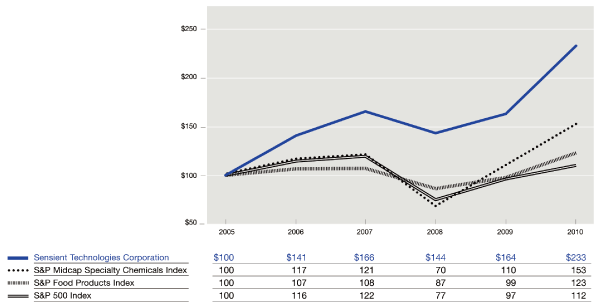
Standard & Poor’s and S&P are registered trademarks of Standard & Poor’s Financial Services, LLC.
49
Five Year Review
| (in thousands except employee and per share data) Years ended December 31, | 2010 | |||||||
Summary of Operations |
||||||||
Revenue |
$ | 1,328,180 | 100.0 | % | ||||
Cost of products sold |
919,821 | 69.3 | ||||||
Selling and administrative expenses |
233,782 | 17.6 | ||||||
Operating income |
174,577 | 13.1 | ||||||
Interest expense |
20,384 | 1.5 | ||||||
Earnings before income taxes |
154,193 | 11.6 | ||||||
Income taxes |
47,049 | 3.5 | ||||||
Net earnings |
$ | 107,144 | 8.1 | % | ||||
Earnings per share: |
||||||||
Basic |
$ | 2.18 | ||||||
Diluted |
$ | 2.17 | ||||||
Other Related Data |
||||||||
Dividends per share, declared and paid |
$ | 0.79 | ||||||
Average common shares outstanding: |
||||||||
Basic |
49,138 | |||||||
Diluted |
49,424 | |||||||
Book value per common share |
$ | 19.70 | ||||||
Price range per common share |
24.76-37.61 | |||||||
Share price at December 31 |
36.73 | |||||||
Capital expenditures |
55,823 | |||||||
Depreciation |
42,109 | |||||||
Amortization |
1,314 | |||||||
Total assets |
1,599,268 | |||||||
Long-term debt |
324,360 | |||||||
Total debt |
349,810 | |||||||
Shareholders’ equity |
983,785 | |||||||
Return on average shareholders’ equity |
11.6 | % | ||||||
Total debt to total capital |
26.2 | % | ||||||
Employees |
3,618 | |||||||
The 2010 results include a credit of $1.5 million ($0.9 million after
tax, or $0.02 per share) for additional insurance proceeds received on the
2009 environmental claims.
The 2009 results include charges for the settlement of environmental
claims and related legal expenses, net of insurance reimbursements, of
$11.3 million ($6.9 million after-tax, or $0.14 per share).
50
Sensient Technologies Corporation Annual Report 2010
| 2009 | 2008 | 2007 | 2006 | |||||||||||||||||||||||||||
| $ | 1,201,412 | 100.0 | % | $ | 1,252,620 | 100.0 | % | $ | 1,184,778 | 100.0 | % | $ | 1,098,774 | 100.0 | % | |||||||||||||||
| 832,382 | 69.3 | 871,754 | 69.6 | 822,479 | 69.5 | 766,506 | 69.7 | |||||||||||||||||||||||
| 222,067 | 18.5 | 219,267 | 17.5 | 214,929 | 18.1 | 202,991 | 18.5 | |||||||||||||||||||||||
| 146,963 | 12.2 | 161,599 | 12.9 | 147,370 | 12.4 | 129,277 | 11.8 | |||||||||||||||||||||||
| 23,788 | 2.0 | 32,306 | 2.6 | 36,127 | 3.0 | 35,748 | 3.3 | |||||||||||||||||||||||
| 123,175 | 10.3 | 129,293 | 10.3 | 111,243 | 9.4 | 93,529 | 8.5 | |||||||||||||||||||||||
| 36,614 | 3.0 | 38,432 | 3.1 | 33,457 | 2.8 | 27,104 | 2.5 | |||||||||||||||||||||||
| $ | 86,561 | 7.2 | % | $ | 90,861 | 7.3 | % | $ | 77,786 | 6.6 | % | $ | 66,425 | 6.0 | % | |||||||||||||||
| $ | 1.79 | $ | 1.91 | $ | 1.66 | $ | 1.45 | |||||||||||||||||||||||
| $ | 1.78 | $ | 1.89 | $ | 1.65 | $ | 1.44 | |||||||||||||||||||||||
| $ | 0.76 | $ | 0.74 | $ | 0.68 | $ | 0.61 | |||||||||||||||||||||||
| 48,379 | 47,654 | 46,740 | 45,900 | |||||||||||||||||||||||||||
| 48,641 | 48,131 | 47,257 | 46,204 | |||||||||||||||||||||||||||
| $ | 18.49 | $ | 16.87 | $ | 17.10 | $ | 15.12 | |||||||||||||||||||||||
| 18.42-29.07 | 21.05-33.12 | 23.66-31.99 | 16.92-25.33 | |||||||||||||||||||||||||||
| 26.30 | 23.88 | 28.28 | 24.60 | |||||||||||||||||||||||||||
| 47,716 | 53,680 | 41,961 | 39,314 | |||||||||||||||||||||||||||
| 40,881 | 42,798 | 42,849 | 41,658 | |||||||||||||||||||||||||||
| 1,302 | 1,647 | 1,463 | 1,386 | |||||||||||||||||||||||||||
| 1,591,691 | 1,525,437 | 1,564,182 | 1,454,067 | |||||||||||||||||||||||||||
| 388,852 | 445,682 | 449,621 | 441,306 | |||||||||||||||||||||||||||
| 428,033 | 479,895 | 507,108 | 532,532 | |||||||||||||||||||||||||||
| 908,695 | 818,596 | 814,421 | 704,104 | |||||||||||||||||||||||||||
| 10.0 | % | 10.7 | % | 10.2 | % | 9.9 | % | |||||||||||||||||||||||
| 32.0 | % | 37.0 | % | 38.4 | % | 43.1 | % | |||||||||||||||||||||||
| 3,570 | 3,613 | 3,623 | 3,582 | |||||||||||||||||||||||||||
51
Directors and Officers
BOARD OF DIRECTORS
Kenneth P. Manning, 69
Chairman and Chief Executive Officer
Sensient Technologies Corporation
Elected Director in 1989 (2, 6)
Chairman and Chief Executive Officer
Sensient Technologies Corporation
Elected Director in 1989 (2, 6)
Hank Brown, 71
President Emeritus
University of Colorado
Elected Director in 2004 (1, 4, 5)
President Emeritus
University of Colorado
Elected Director in 2004 (1, 4, 5)
Fergus M. Clydesdale, Ph.D., 74
Distinguished Professor,
Department of Food Science, and Director
of the Food Science Policy Alliance at the
University of Massachusetts — Amherst
Elected Director in 1998 (2, 3, 4, 6)
Distinguished Professor,
Department of Food Science, and Director
of the Food Science Policy Alliance at the
University of Massachusetts — Amherst
Elected Director in 1998 (2, 3, 4, 6)
James A.D. Croft, 73
Chairman
Bartlodge Limited
Elected Director in 1997 (1, 2, 3, 6)
Chairman
Bartlodge Limited
Elected Director in 1997 (1, 2, 3, 6)
William V. Hickey, 66
President and Chief Executive Officer
Sealed Air Corporation
Elected Director in 1997 (1, 2, 4, 5)
President and Chief Executive Officer
Sealed Air Corporation
Elected Director in 1997 (1, 2, 4, 5)
Peter M. Salmon, 61
President
International Food Network, Inc.
Elected Director in 2005 (5, 6)
President
International Food Network, Inc.
Elected Director in 2005 (5, 6)
Elaine R. Wedral, Ph.D., 66
Retired, Former President
Nestle’s Research and Development
Worldwide Food Service Systems
Elected Director in 2006 (5, 6)
Retired, Former President
Nestle’s Research and Development
Worldwide Food Service Systems
Elected Director in 2006 (5, 6)
Essie Whitelaw, 63
Retired, Former Senior Vice President, Operations
Wisconsin Physician Services
Elected Director in 1993 (3, 4)
Retired, Former Senior Vice President, Operations
Wisconsin Physician Services
Elected Director in 1993 (3, 4)
| COMMITTEES | ||
| 1 | Audit Committee | |
| 2 | Executive Committee | |
| 3 | Compensation and Development Committee | |
| 4 | Nominating and Corporate Governance Committee | |
| 5 | Finance Committee | |
| 6 | Scientific Advisory Committee |
ELECTED OFFICERS
Kenneth P. Manning, 69
Chairman and Chief Executive Officer
With the Company 23 years
Chairman and Chief Executive Officer
With the Company 23 years
John F. Collopy, 41
Vice President and Treasurer
With the Company 11 years
Vice President and Treasurer
With the Company 11 years
Christopher M. Daniels, 37
Vice President, Human Resources
With the Company 11 years
Vice President, Human Resources
With the Company 11 years
John L. Hammond, 64
Senior Vice President, General Counsel and Secretary
With the Company 13 years
Senior Vice President, General Counsel and Secretary
With the Company 13 years
Gordon E. Hering, Ph.D., 54
Vice President, Marketing & Technology
With the Company 16 years
Vice President, Marketing & Technology
With the Company 16 years
Richard F. Hobbs, 63
Senior Vice President and Chief Financial Officer
With the Company 37 years
Senior Vice President and Chief Financial Officer
With the Company 37 years
Jeffrey T. Makal, 47
Vice President, Controller and Chief Accounting Officer
With the Company 14 years
Vice President, Controller and Chief Accounting Officer
With the Company 14 years
Richard J. Malin, 44
Assistant Controller
With the Company 19 years
Assistant Controller
With the Company 19 years
Paul Manning, 36
President, Color Group
With the Company 1 year
President, Color Group
With the Company 1 year
James P. McCarthy, 58
President, Flavors & Fragrances Group
With the Company 2 years
President, Flavors & Fragrances Group
With the Company 2 years
Douglas S. Pepper, 58
President and Chief Operating Officer
With the Company 5 years
President and Chief Operating Officer
With the Company 5 years
Stephen J. Rolfs, 46
Vice President, Administration
With the Company 13 years
Vice President, Administration
With the Company 13 years
Robert J. Wilkins, 54
President, Asia Pacific Group
With the Company 7 years
President, Asia Pacific Group
With the Company 7 years
APPOINTED OFFICERS
Douglas L. Arnold, 47
Vice President, Administrative Services
With the Company 13 years
Vice President, Administrative Services
With the Company 13 years
Patrick E. Laubacher, 53
President, Dehydrated Flavors
With the Company 30 years
President, Dehydrated Flavors
With the Company 30 years
Robert L. Menzl, 54
Vice President, Information Technology
With the Company 15 years
Vice President, Information Technology
With the Company 15 years
Edward E. Savard, 45
Vice President, Engineering
With the Company 17 years
Vice President, Engineering
With the Company 17 years
52
Investor Information
World Headquarters
777 East Wisconsin Avenue
Milwaukee, Wisconsin 53202-5304
(414)271-6755
(800) 558-9892
Fax: (414) 347-4795
E-mail: corporate.communications@sensient.com
Web site: www.sensient.com
Milwaukee, Wisconsin 53202-5304
(414)271-6755
(800) 558-9892
Fax: (414) 347-4795
E-mail: corporate.communications@sensient.com
Web site: www.sensient.com
Transfer Agent and Registrar
Wells Fargo Bank Minnesota, N.A.
Shareowner Services
P. O. Box 64854
St. Paul, Minnesota 55164-0854
(800)468-9716
Web site: www.wellsfargo.com/shareownerservices
Shareowner Services
P. O. Box 64854
St. Paul, Minnesota 55164-0854
(800)468-9716
Web site: www.wellsfargo.com/shareownerservices
Common Stock
Sensient Technologies Corporation Common
Stock is traded on the New York Stock Exchange.
Ticker symbol: SXT.
Stock is traded on the New York Stock Exchange.
Ticker symbol: SXT.
There were 2,962 shareholders of record of Common Stock as of January 31, 2011.
Annual Meeting of Shareholders
The Annual Meeting of Shareholders will be held at 2:00 p.m.
(CDT) on Thursday, April 21, 2011, at Trump International Hotel, 401 N. Wabash Avenue,
Chicago, Illinois.
Annual Report and Proxy Statement
The Company’s annual report and proxy statement are available online at www.sensient.com/financial/annualreport_and_proxy.htm.
Form 10-K
The Company’s annual report filed with the Securities and Exchange Commission on Form 10-K is
available without charge from the Company’s Investor Relations Department and on its Web site at
www.sensient.com.
In accordance with New York Stock Exchange rules and pursuant to Rule 13a-14 under the Securities
Exchange Act of 1934, Kenneth P. Manning, as the Company’s Chief Executive Officer, and Richard F.
Hobbs, as the Company’s Chief Financial Officer, have certified the quality of the Company’s public
disclosure in an exhibit to the Company’s Annual Report on Form 10-K for the year ended December
31, 2010.
Dividends
Quarterly dividends are typically paid on the first
business day of March, June, September and December.
Automatic Dividend Reinvestment Plan
The Sensient Technologies Corporation Dividend Reinvestment
Plan provides shareholders with a convenient, economical way to increase their ownership of
Sensient Technologies Corporation Common Stock. Through the plan, shareholders can automatically
reinvest their dividends to acquire additional shares and make supplemental stock purchases without
paying fees or commissions. An enrollment form and brochure describing the plan can be obtained by
contacting the plan administrator, Wells Fargo Bank Minnesota, at (800) 468-9716 or the Company’s
Investor Relations Department at (414) 347-3779.
Investor Relations
Communications concerning the transfer of shares, lost certificates, duplicate mailings or change
of address should be directed to the transfer agent.
Other shareholder information, such as news releases and information regarding corporate
governance, is available on the Company’s Web site: www.sensient.com. Shareholders can also
register to receive notification via e-mail when new information is added to the site. The
Company’s Web address is provided as an inactive textual reference only, and the contents of the
Web site are not incorporated in or otherwise to be regarded as part of this annual report.
Other requests for information should be directed to the Company’s Investor Relations
Department at (414)347-3779.
The Company maintains a direct mailing list for news releases and quarterly reports. If you would
like your name added to this list, please contact the Company’s Investor Relations Department.
